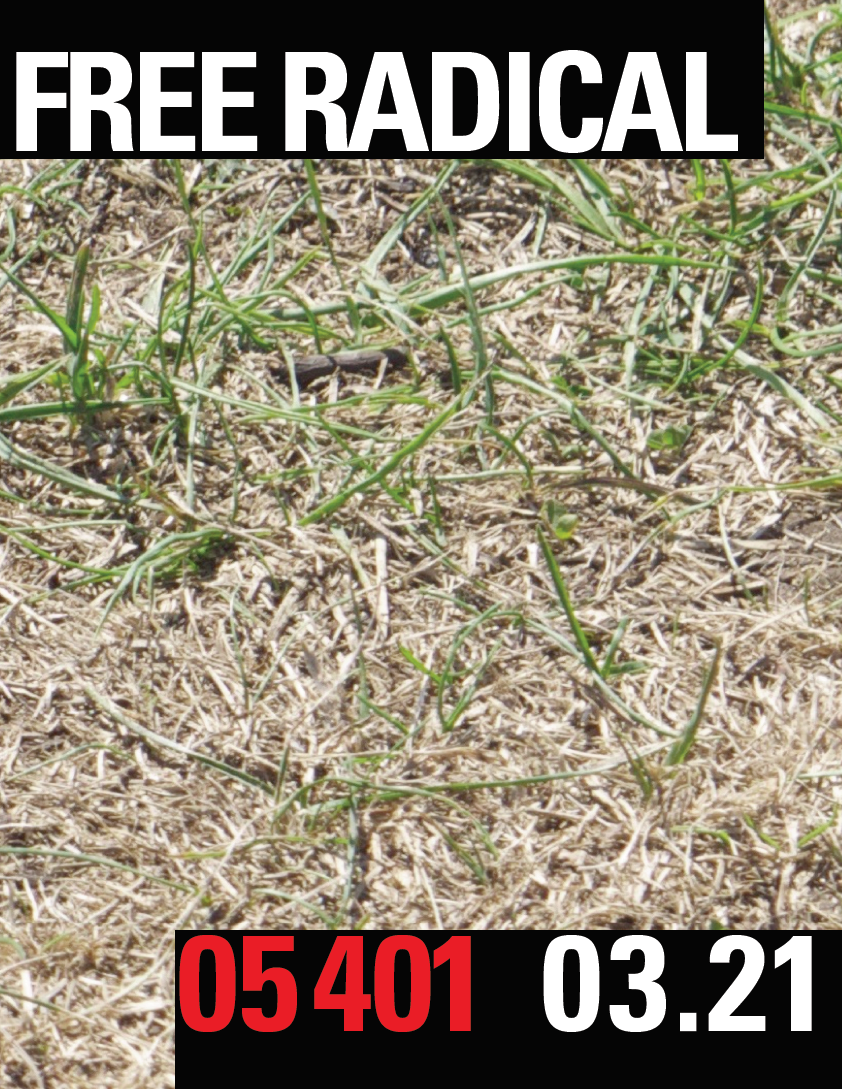
March 2021 – FREE RADICAL VII
OPINION
LOUIS MANNIE LIONNI
LETTERS
BALLROOM
NAOMI SILVER
THE VESPA
MICHAEL MONTE
VERMONT MEMORIAL PARK
LOUIS MANNIE LIONNI
THE F-35
JAMES MARC LEAS
POETRY :
RALPH CULVER
NEIL HEIMS
MADELEINE MAY KUNIN
ANNA BLACKMER
GREG DELANTEY
DAN ROSEN
MEMORIAL BUS SHELTER
LOUIS MANNIE LIONNI
WORLD FOOD SYSTEM
CHARLES SIMPSON
THE LAMBRETTA
LOUIS MANNIE LIONNI
THE MITTENS
BARRY SNYDER
TINY PANDEMIC POEMS
CINSE BONINO
March 2021 – FREE RADICAL VII
Fool me once, shame on you ; fool me twice, shame on me …
Most of us saw the con coming, but not the Mayor nor the City Councilors. Don Sinex was going to do a project like no one has ever done before, and the administration bought into it in a flash. It didn’t work out (surprise !) and Sinex’s Daddy Warbucks stepped in, made the same promises, and the administration rolled over once again. But (surprise !) Sinex’s (much) larger partner sweet-talked everyone to another dead end. So the administration sued the developer, and of course got sued back in return. And Don Sinex is back, with new, local partners. Fool me once, shame on you ; fool me twice, shame on me ; fool me three times…
We are barely past the presidential elections ; by the time this issue of 05401 is ready to print the negotiations over the space which should be Vermont Memorial Park will be eclipsed by national events. But we should not lose sight of the importance of responding to the global environmental crisis at the local level with a radical gesture. We cannot allow development to continue to gobble up the natural resources ; building a park where conventional foolishness suggests hundreds of unaffordable housing units would be the beginning of a radically assertive infusion of true environmental values into our daily lives.
There is a pressing need for affordable housing. But the current dribble down of a few, often segregated affordable units, always at a heavy environmental cost, has gotten us no closer to closing the affordability gap. No matter who wins the next mayoral election, things have to change,
SOCIAL DISTANCING
Frank Lloyd Wright was anticipating the modern middle-class family when he removed the walls from the kitchen and moved it to the center of the house as part of the larger living / dining space.
Social distancing : this is not a new thing. It goes back to the beginnings, the family, the tribe and—eventually—the state. Architecture is social distancing. Neighborhoods are social distancing. Racism, discrimination and segregation are social distancing. The bedroom door and the bathroom door are social distancing. Sex is not.
Apartments—apart—are social distancing. So are jails, prisons and federal penitentiaries. “Solitary” is social distancing. Bumper cars are the transgression of social distancing. “Leave me alone” is social distancing ; “Don’t bother me !”
Some activities tend inevitably towards social distancing. Others do the opposite. Social distancing is culturally constructed. Many people who object to social distancing in the pandemic do lock their front doors. Some have burglar alarms to ensure social distancing.
Social distancing and social dancing are mutually exclusive. So are social distancing and the extension of social dancing : the urge to couple.
Vermont is used to social distancing. I remember moving here, forty years ago, to a house on Orchard Terrace. We waited in vain for a neighbor to invite us for a cup of coffee, and perhaps a cinnamon bun, or a scone, or just cookies. Anything. On the other hand, when—some years later—we moved to a new house with too little room but a terrific view of the Lake and the Adirondacks out the back yard, some young persons suddenly appeared to help us load and transport our material possessions, unbidden. I did not ever get to know who they were. All of this characterizes some Vermonters’ attitudes towards social distancing : a respect for others’ privacy and a willingness to help a stranger in need. This sounds corny, but I think it’s true.
Scandinavians—Norwegians in particular— are gregarious people in the dark of winter. They socialize excessively and probably drink too much. But as social as they are in winter , so are they distanced—they prefer to be—in the summer. Those who can, disappear to remote cabins in the wilderness ; much as Vermonters used to do when they could. Scandinavian summers are short but very intense, above the arctic circle the sun travels slowly within view for the entirety of each 24 hours at the height of summer.
Winter is a time of tribulation : contested elections, a pandemic resurgent, wild weather swings to extremes never experienced in any of our lifetimes—floods, fires, extremes of temperature and—depending on your point of view—the potentially disastrous or beneficial reversal of social gains that once seemed firmly, definitively achieved.
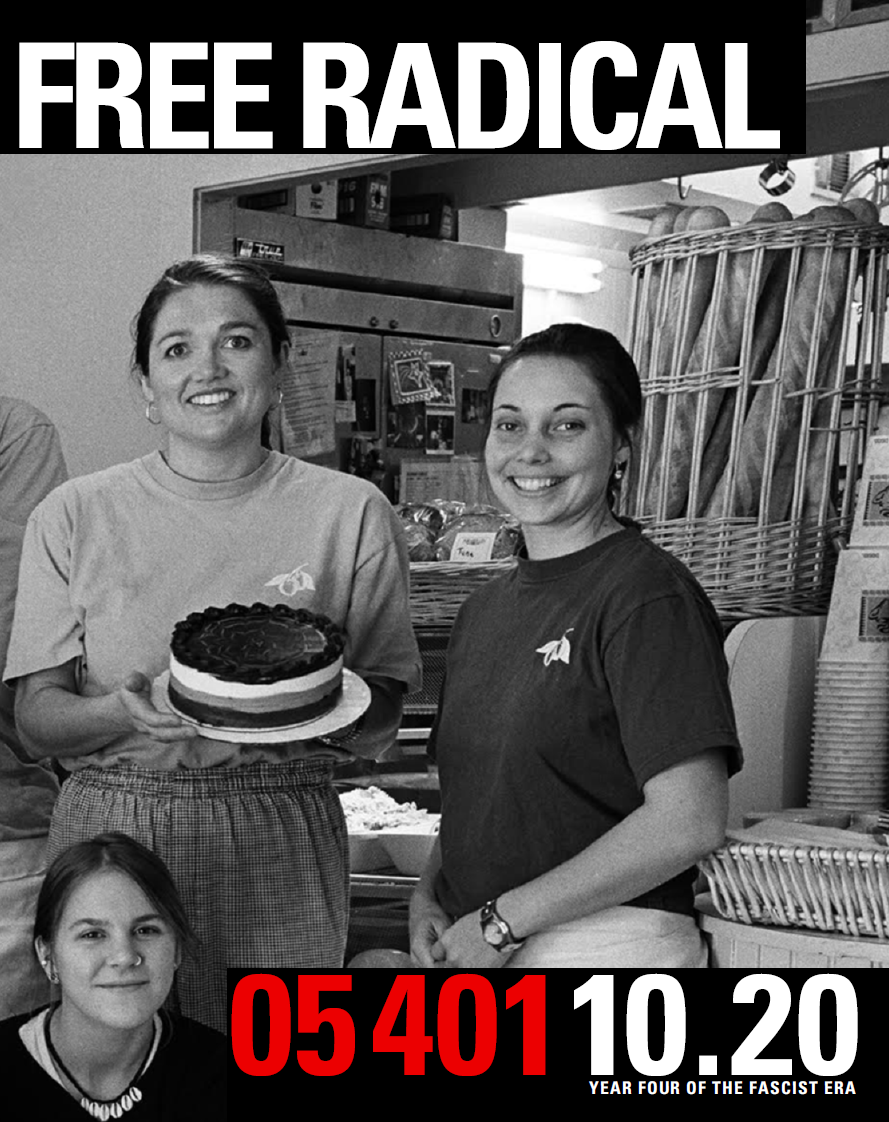
October 2020 – FREE RADICAL VI
LOSS
Louis Mannie Lionni
LETTERS I
Sandra Baird, Peter Garritano, Mark Estrin,
Louis Mannie Lionni
EVERYTHING ABOUT UKULELES
Peter Guss
SARAH HOLBROOK CENTER
Duncan Wisniewski Architects
Louis Mannie Lionni
DIARY 1933
Terry Gips
DIARY 1933
Francis Pesko
THE VALLEY of ANCIENT MALICE
CHAPTER ONE : MY WORLD
Samuel Lionni Guss
PORTFOLIO
Patricia McPike
MY MIRABELLES
Eleanor Lanahan
WITSON
Russell Methlie
PROFITTI E PERDITE
Antonello Borra
LETTERS II
Albert Petrarca et al
October 2020 – FREE RADICAL VI
Sometime during the winter, Shelburne Shipyard was sold. Word was that Mary had been offered four million but disliked the person. She sold it to someone else for three. So they say.
A few years ago I had my only real conversation with Mary. I had asked her how it was that she was not building condos, a restaurant ; her answer was characteristically brief : “We’ve been in the shipyard business for one hundred and twenty five years. That’s what we do.”
By May of this year Mary had moved to Southern California, and the other women were gone : Karen, the office manager ; the other Karen, the administrative assistant ; and Belinda, who had worked with Rick as a rigger until he retired and then had taken over that job and become manager of the store as well. All of them smart, competent.
The new owners of the shipyard are a conglomerate of about one hundred marinas nation-wide. That in itself is unsettling to those of us who valued the traditionally local nature of the Marina’s owners, but by June word was that the new owners were negotiating to sell their entire holding of marinas to a trans-national corporation.
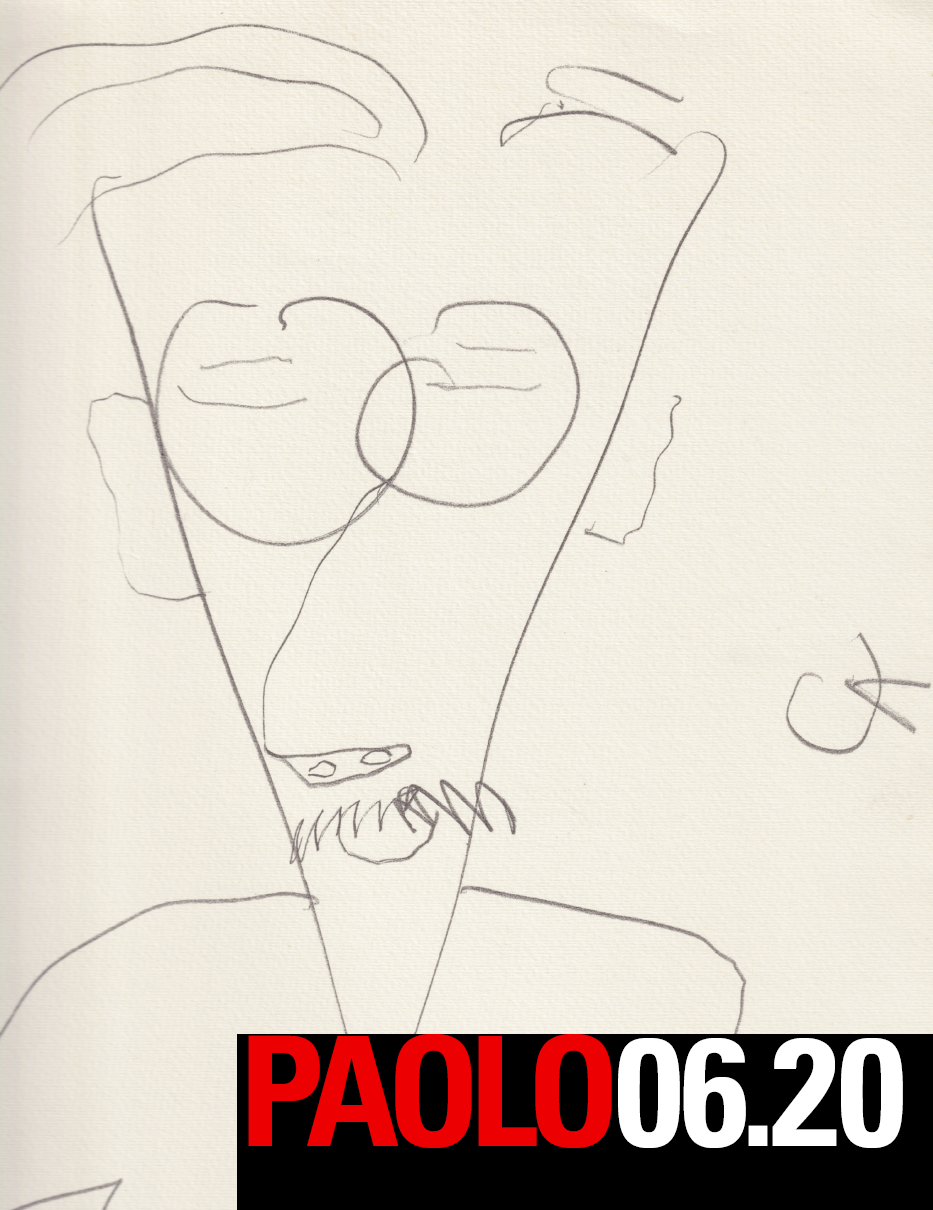
June 2020 – PAOLO
June 2020 – PAOLO
My brother was a poet. He had blond curly hair as a baby ; he was bad in High School ; he dropped out of college after one year ; he hung out with the Beats, was one of them, had a heroin habit and became, for the last fifteen years of his life, a middle management Scientologist. He described himself as the intellectual left wing of Scientology.
This is my tribute to him.
Paolo was born in Switzerland on the 27th of December, 1938. In August of 1939 he and I, and my mother, boarded an Italian liner, the Conte di Savoia, bound from Genova to New York. My father had preceded us by six months to search for a job, rent and furnish an apartment. Years later we all became citizens and we all spent most of the rest of our lives in the United States.
My mother always felt that my brother had had a difficult life, and that it was her fault, that she had transmitted her anxieties about fascism and the threat of war to him, first in utero and then in the months after his birth preceding our departure from Italy. I tried to convince her that maybe Paolo had had an exciting life, difficult yes but challenging and—at times—rewarding, and that if fault was to be found it was with Mussolini and the fascist regime that had repeatedly jailed and exiled Paolo’s grandfather and had persecuted so many of my parents’ friends and other relatives. She never bought it.
Paolo was six years younger than me, a generational divide during our first years together. We had different interests, different friends. I was mature, he was a child.
After his brief College career Paolo lived in New York, Los Angeles, and in England, France, and Italy. As adults we were estranged for a time, our lifestyles too radically different, our attitudes about drugs too irreconcilable. Paolo was—for a time—art director of Opera News, the magazine of the Metropolitan Opera, and then, for its brief existence, the art director of USA 1, a glossy monthly that had been set up to promote the political ambitions of Governor George Romney, who was mounting a challenge for the Presidency. During his years as a Scientologist Paolo produced records by The Incredible String Band and Chick Corea. After Paolo joined the Church of Scientology he got sober and we reconciled our differences. For the remainder of his life we had an affectionate, cautious relationship. We were adults together.
Paolo died in 1986 from the ravages of lung cancer, cared for by his friends in the Church of Scientology and by his wife Jane. He left a son, Sylvan, by a previous marriage to Lucienne.
Paolo was, most fundamentally, a poet. Especially in his twenties, when he hung out with the Beats and produced a small body of poetic and editorial work ; but also during the rest of his life, working at other things, he retained a poetic way of seeing and thinking and expressing himself. His friends thought he was deep. In the process of preparing this tribute to my brother I was surprised to discover that about him. We had always been affectionate, but he was, after all, a child to my way of thinking. Just as your children never seem to grow up, so it can be with younger brothers, apparently.
The Liepzig Connection was Paolo’s contribution to the discussion that surrounded the conflicts between traditional and progressive education. Early editions of the Leipzig Connection credit a co-author, Lance Klass, and their relative contributions to the book are in some dispute. The core argument of the book highlights the fortuitour coming together of a new discipline–behavioral psychology– with an enormous source of money, since John D. Rockefeller was, at the moment, under significant pressure to dispose of much of his wealth and seized at the chance to bankroll a radical transformation of American education.
Paolo often described himself as the intellectual left wing of Scientology. But it was not that simple. for a while he was an admirer of Lyndon LaRouche, attracted, I think, by LaRouche’s neo-renaissance rhetoric. Paolo was, towards the end of his life, close to George Dalmeida, a painter and renaissance scholar. George wrote a beautiful, poetic appreciation of Paolo [page 54]
Our father was an ambitious and successsful renaissance man. I chose to steer clear of the ambition, the success and the renaissance. Paolo, on the other hand, chose to challenge life on our father’s terms. He sought success, worked—as our father had—as a graphic artist, initiated many projects in the arts, but ultimately found his true self in education, within a therapeutic community of teachers and learners.
05401
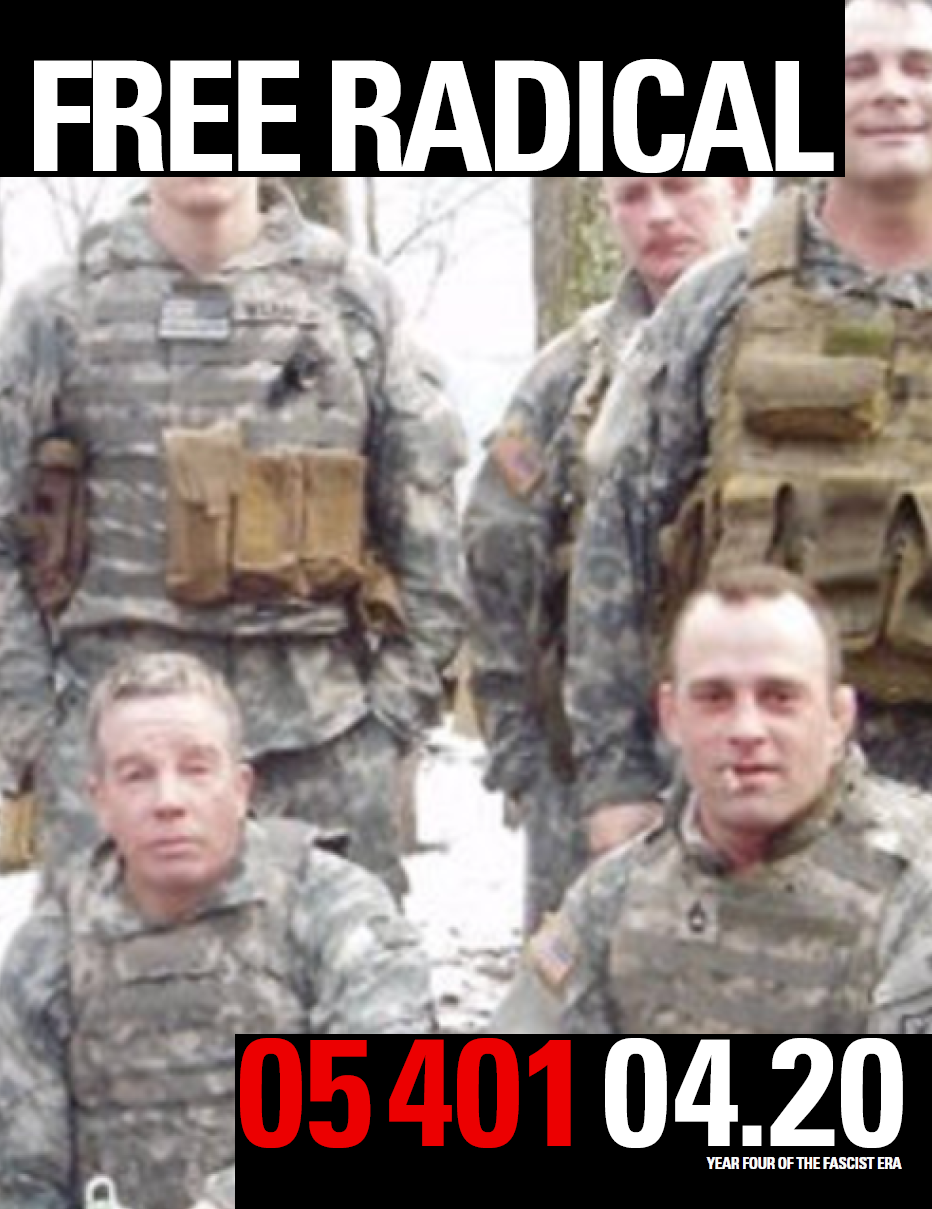
April 2020 – FREE RADICAL V
Choosing Interior Color
LOUIS SAUER
Construction Sight
VERONICA MORGAN
The Sculpture of Leslie Fry
WILLIAM LIPKE
Missing Burlington College
LOUIS MANNIE LIONNI
Hi Fi
JOHN KIMURA
Extinction
CHARLES SIMPSON
Music has Charms to Soothe
the Stinking Breath
MARC ESTRIN
Receiving the Nobel Prize
ALBERT CAMUS
April 2020 – FREE RADICAL V
The new City Council is in for a rough ride. It faces a possible transformation of our national government into a parliamentary dictatorship, before the 2020 elections—in which case there will be no elections— during the 2020 elections or after the 2020 elections. Each of these possibilities would radically transform the relationship of national government with the fifty states and with all of our country’s municipalities.
It’s not hard to imagine. But you might take a good long look at the French TV series— available on Amazon Prime—A French Village. This is a moving narration of life in a French village just before, during and after the second world war. Under German occupation, villagers confront painful moral dilemmas, opportunistic collaboration, cruel retaliations and courageous acts of self-sacrifice and defiance.
Given Trump’s behavior over the past three years and his response to the impeachment and to his acquittal by a sycophantic Senate, there is every reason to imagine that he will find the pretext to declare a national emergency and impose martial law, dissolving the House of Representatives, jailing the leaders of the Democratic party—but not only the leaders—removing and replacing sitting Democratic State Governors and imposing political prefects on all states and municipalities. Local police would be placed under control of the military, National Guard units would be deployed to maintain order and prevent opposition to the regime.
Most of us hope this won’t happen. But is that realistic ? And doesn’t it seem prudent for the City Council to begin to think seriously about how they will act if it does ?
We can’t expect real leadership from the Mayor’s office ; he’ll be up for re-election in 2021.
Neil Heims has written a very compelling book—not yet published— about the aborted, incomplete revolutions of the nineteen sixties ; but it turns out that we are about to face the consequences of the deeper failure of the Revolution of 1776 to shield us sufficiently— try as the founders did—from our own worst selves, and the failure of the Civil War to stop racial violence and then reconcile the conflicting sides of that terrible war.
It was a long time coming, but here we are ! The City Council is our form of representative government. It is imperfect, but so are we all. Our other nodes of community solidarity are the neighborhood planning assemblies ; at present, their loose organization and ambiguous location in the hierarchy of municipal power would seem to be failings, but under an autocratic regime, under a dictatorship—it’s hard to use that word, but that’s where we are—those very deficiencies would be assets. The City Council must continue to oppose any authoritarian forms of local repression ; at the same time, the neighborhood planning assemblies, or some version of them, must be the spearhead of our resistance.
Does this sound nuts ? Hitler and Mussolini came to power in parliamentary democracies by what were then and there legitimate means, albeit abetted by bullying and violence. In both Germany and Italy, the transition to totalitarianism was swift and absolute. We’re halfway there.
At the very least, the City Council should be speaking to the members and the leaders of the Guard. Would they, if ordered to do so, attack civilian Vermonters ? It has happened before, in other states. Or would they defend Vermonters from an attempt to dismantle our democratic, representative municipal institutions ? Would they support secession, fight for our rights ? Or would they follow illegal orders, no matter where those orders led ? Where would be the loyalty of guard members stationed overseas ? To their government, or to their brothers and sisters, their families and friends ? The cautious, moderate move is to do nothing, wait and hope it doesn’t happen ; the reasonable, radical move is to act now, begin the hard conversations before we are caught up in an inferno for which we are completely unprepared.
In 1939 my father decided to leave Italy and come to America. He went to Amsterdam to tell his parents, and to tell them that they should leave also. They wished him well, but there was no way that they would leave their beautiful apartment. Architecture has that kind of power ! They subsequently fled, minutes ahead of the Gestapo, on a small fishing boat to England, and then—eventually— to the United States. How many Jewish families were killed before and during the Second World War because they did not want to leave their homes and their furniture ? We need to anticipate the future, and act accordingly.
05401
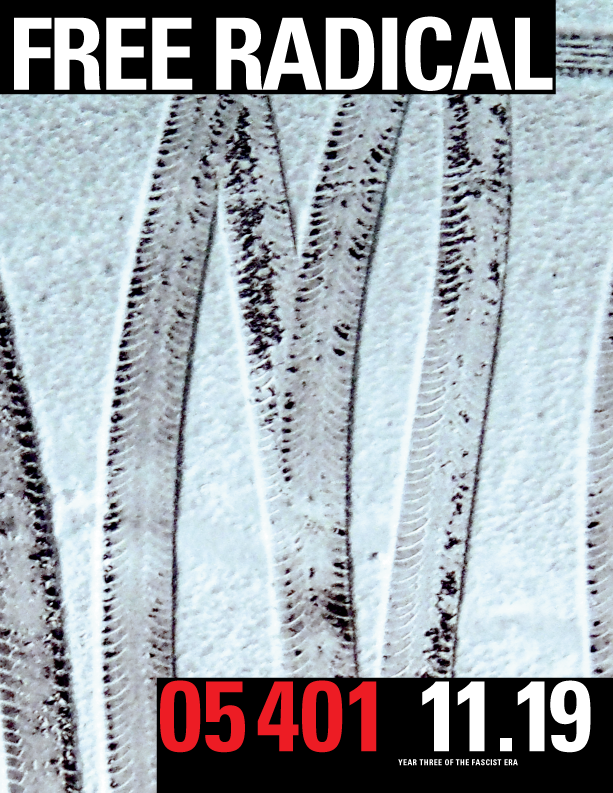
November 2019 – FREE RADICAL IV
LOUIS MANNIE LIONNI
OPINION
SMITH ALVAREZ SIENKIEWYCZ
NICHOLSON HOUSE at UVM
LOUIS MANNIE LIONNI
RUMI
DEBBIE BOOKCHIN
LIBERTARIAN MUNICIPALISM
and MURRAY BOOKCHIN’S
LEGACY
CINSE BONINO
INTOLERANCE
ANNIE LIONNI
UNFINISHED BUSINESS
DAVID SELLERS
GESUNDHEIT
BRIAN MAC
MURAL HOUSE
JEANNE GANG
RICHARD GILDER CENTER
LOUIS MANNIE LIONNI
MORAN FOREVER
MARK ESTRIN
THE SUSTAINABLE ENERGY of
the BREAD & PUPPET THEATER
SHARYL GREEN
BURLINGTON CO-HOUSING
EAST VILLAGE
SHARYL GREEN
ONE TAKE ON THE FIRST TEN
YEARS
MICHAEL WISNIEWSKI
PORTFOLIO
RUMI
THE VISIONS OF DAQUQI
LOUIS MANNIE LIONNI
PAOLO
November 2019 – FREE RADICAL IV
CLOSE DOWN THE MILITARY. ALTOGETHER. PERMANENTLY.
It’s obvious, rational, radical, sensible and imperative, if we are ever going to get this country together. But it’s complicated, and it’s going to require hard thinking by brave people. So, it’s not on the agenda—for now. If you want to participate in the discussion please e-mail your written contributions, in Word format, 700 to 3,000 words by Nov 13.
It’s all one messy discussion : the environment, domestic policy, foreign policy, economics, peace, justice, freedom—all part of what needs to be a process of acknowledgement and reconciliation of old injustices, present inequities, and a peaceable future. For starters, one simple and paradoxical fact is that the left—if we can still use this term— has had a very problematic relationship with environmental issues. The left’s focus on social justice and social needs has often pitted it against the needs of the environment. It is the legacy of the last almost forty years of progressive leadership in our city. Time and again, starting with Bernie Sanders’ endorsement of the Alden Waterfront plan, progressives had led the fight for luxury housing on the grounds (mirage) that it would include (negligible numbers of) affordable housing and/or other social benefits. And time and time again the environmental aspects were trivialized or disregarded altogether.
On the national scale the current administration’s war on the environment doesn’t even attempt to suggest social benefits ; it is simply a part of the general strategy of domination— over land, water, nature, women, people of color and members of the LGBTQ community—over us all—by an oligarchy, abetted by a vast coterie of deluded supporters. The ambition of Burlington’s administration is more modest, but no less indifferent to its environmental impacts. Many of the practices of the national administration would have been unthinkable three years ago ; but do you believe that there aren’t developers eyeing the Burlington waterfront ? An expansion of the Perkins Pier public marina would have expanded affordable boating for residents ; but the Mayor doesn’t support it, and the site will be an excellent location for a hotel. Want to bet it doesn’t happen ? It’s normal, in life, to be vigilant. In this life, in the face of the continued assault on the environment, vigilance is imperative ; we cannot let up, we cannot look the other way, we cannot be disheartened.
I always intend to approach every opinion piece in 05401 with an open mind. Who needs yet another editorial condemning the Mayor and the City Council for yet another inappropriate move against the public they are elected—and paid—to represent ? I wish I could tell you that things are looking up, that housing in the city is becoming more affordable, that community policing is working, that wage inequality is subsiding, that the kids are all right ; but it just ain’t so.
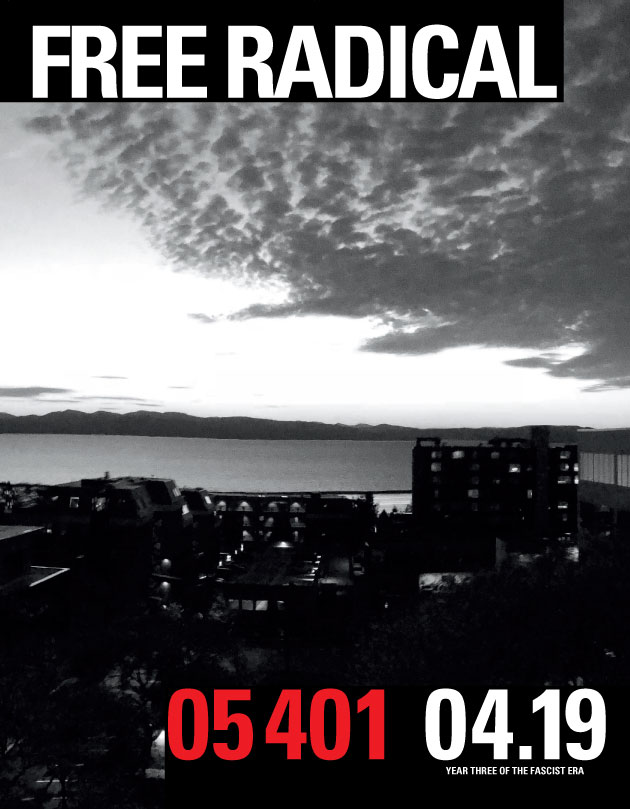
April 2019 – FREE RADICAL III
LETTERS
LOUIS MANNIE LIONNI
OUR CITY
INFINITE CULCLEASURE
MANAGING THE PAIN
LOUIS MANNIE LIONNI
PHILIP JOHNSON
LOUIS MANNIE LIONNI
THE FELLOWSHIP OF
RECONCILIATION
LOUIS MANNIE LIONNI
LE CORBUSIER
ERIK REHMAN
HOW YOU DOIN’?
ANTI LANDSCAPE
DIANE ELLIOTT GAYER
SAMSON WAS a STRONGMAN
LONG AGO
LOUIS MANNIE LIONNI
NATALIIE GRIFFIN de BLOIS
ANONYMOUS
METHADONE :
THE BENEVOLENT OPIATE
DAVID KARP
LOUIS KAHN
LOUIS MANNIE LIONNI
LEET’S LOOSEN UP A LITTLE
ELEANOR HENDERSON
ST PAUL’S CATHEDRAL
WILLIAM HENDERSON
DRAWING
LOUIS MANNIE LIONNI
PETER COOK
LOUIS MANNIE LIONNI
FRANK LLOYD WRIGHT
HEATHER KOHSER
WINGS IN WINTER
LOUIS MANNIE LIONNI
BUCKMINSTER FULLER
MARTIN TIERNEY
EXCERPT FROM “AT THE
EDGES”
April 2019 – FREE RADICAL III
LOUIS MANNIE LIONNI
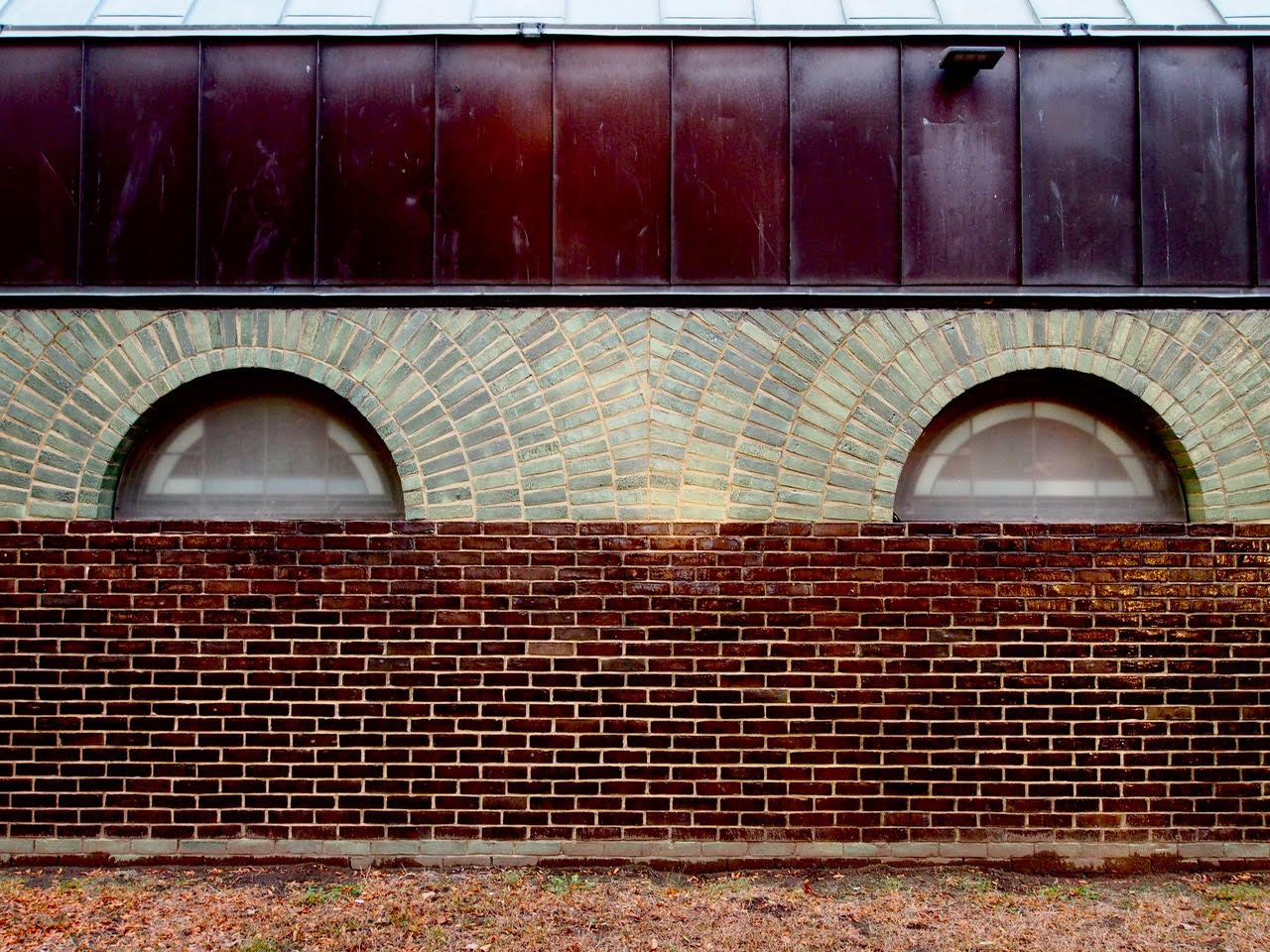
I’ve written before about this ; it needs repeating. Retire the Guard ; it is a useless, malevolent institution. Not the Guardsmen and women, they are like the rest of us, imperfect, doing the best we can, mostly, but the institution is a waste of time, money and humanity. Ultimately malevolent, even if it has fortunately never been actually called to perform its murderous mission. Retire the Guardsmen and women at full pay, it won’t cost us any more than if we don’t. And throw in a free College education for those who haven’t been able to have one, or a real job training program. Help them fulfill their better destiny, become artists—painters, sculptors, print-makers, graphic artists, composers, performers, novelists, essayists, poets, journalists—or scientists, or academics, or businesspersons, or caregivers, social activists, plumbers, electricians, carpenters, cabinet makers, mechanics, race car drivers. Something useful. Think about it, four thousand full blown adults loosed upon our state to enrich us all ! That’s only the beginning. If we’re serious about creating a sustainable human presence on earth, a sustainable presence of the earth itself, we must do more. Quickly ! Mobilize our congressional delegation ; get them to stop their suicidal behavior ; commit them to a radically different agenda than the one they have been pursuing, now, for too many years ; have them call the Defense Department, and tell it to forget about the F35s, and to take their junk away, the planes and trucks and other paraphernalia of war. Not just from the airport, but from our (their) police departments as well. Work out a plan for retiring the vast majority of the armed forces at full pay with educational and health benefits (if we can pay them to fight we can pay them to do something useful). Initiate talks on nuclear disarmament ; hang in until there is an international treaty to ban all nuclear weapons over an apparently ridiculously—but absolutely essential— short period of time. Life is of the essence !
If you’re with me on this, let’s move it forward. There are an infinity of difficult decisions ahead, but you get the point : either we overcome our lethargy and fear and reverse the course of our recent history or we are fucked ! We, them, our children, their children, everybody’s children. Fucked ! That’s only the military part. If you wonder what a radical national agenda is doing in a local—and localizing—magazine, I would argue that if once we were taught to think global and act local, the distinctions between thinking and acting, between local and global, have evanesced.
Just as global politics drive local agendas, local ideologies and local governances, local action has become a prerequisite for national and international change. If communities in this country and abroad don’t take on the staggering income disparities, the militarization of the polis, the issues related to AI and robotization, massive environmental degradation— you know the list—there is no chance for a radical reversal of the global unraveling.
Here in the Champlain Basin
We have tended to see ourselves—and be seen by others—as disconnected from the rest of Vermont. It would be good if both we and other Vermonters could make the effort to see each other as more. Not less, or even different, just more, all of us, than our individual parts. We should be working at that. But, just as importantly, it is imperative that we take much more seriously, right now, our relationship to/with the rest of the Champlain Basin. We are trading partners, cultural interlocutors, and co-beneficiaries and stewards of one of the hemisphere’s great lake æcologies.
Finally, with respect to the architectural criticism on the following pages :
05401 wants to be a magazine of local culture.
But we can’t blind ourselves to what is going on in other parts of the world, or what has gone on elsewhere over times past. The four houses and the work of Archigram and Peter Cook are reminders that we live in a historical context—modernism—which conditions all of our work, our architectural work in particular. The housing crisis in the Champlain Basin is not simply a question of money ; money counts, in matters military and domestic. But so does an understanding of the historical processes that have gotten us here, and that can sustain us as we go on. The houses that are reviewed in this issue have been the subject of intense academic and professional criticism ; I repropose them for what they can stimulate in our own cultural/historical enterprise. It is not necessary to be an architect or an architectural historian (or a politician) to subject the built environment to a critical eye ; or to see architecture as something connected to the rest of experience.
05401

January 2019 – FREE RADICAL II
LOUIS MANNIE LIONNI
OPEN SPACE
LOUIS MANNIE LIONNI
WHAT DO WE WANT ?
WHEN DO WE WANT IT ?
LETTERS
LOUIS MANNIE LIONNI
FICTION
LOUIS MANNIE LIONNI
and CAROLYN BATES
CAMBRIAN DEATH
JAMES LOCKRIDGE
THE TYRANNY of CUSTOM
LOUIS MANNIE LIONNI
CATHEDRAL of THE
IMMACULATE
DEMOLITION
ROLF KIELMAN
BIRD HOUSING
GINA ZUCKER
BIRTH OF A WOMAN
January 2019 – FREE RADICAL II
LOUIS MANNIE LIONNI
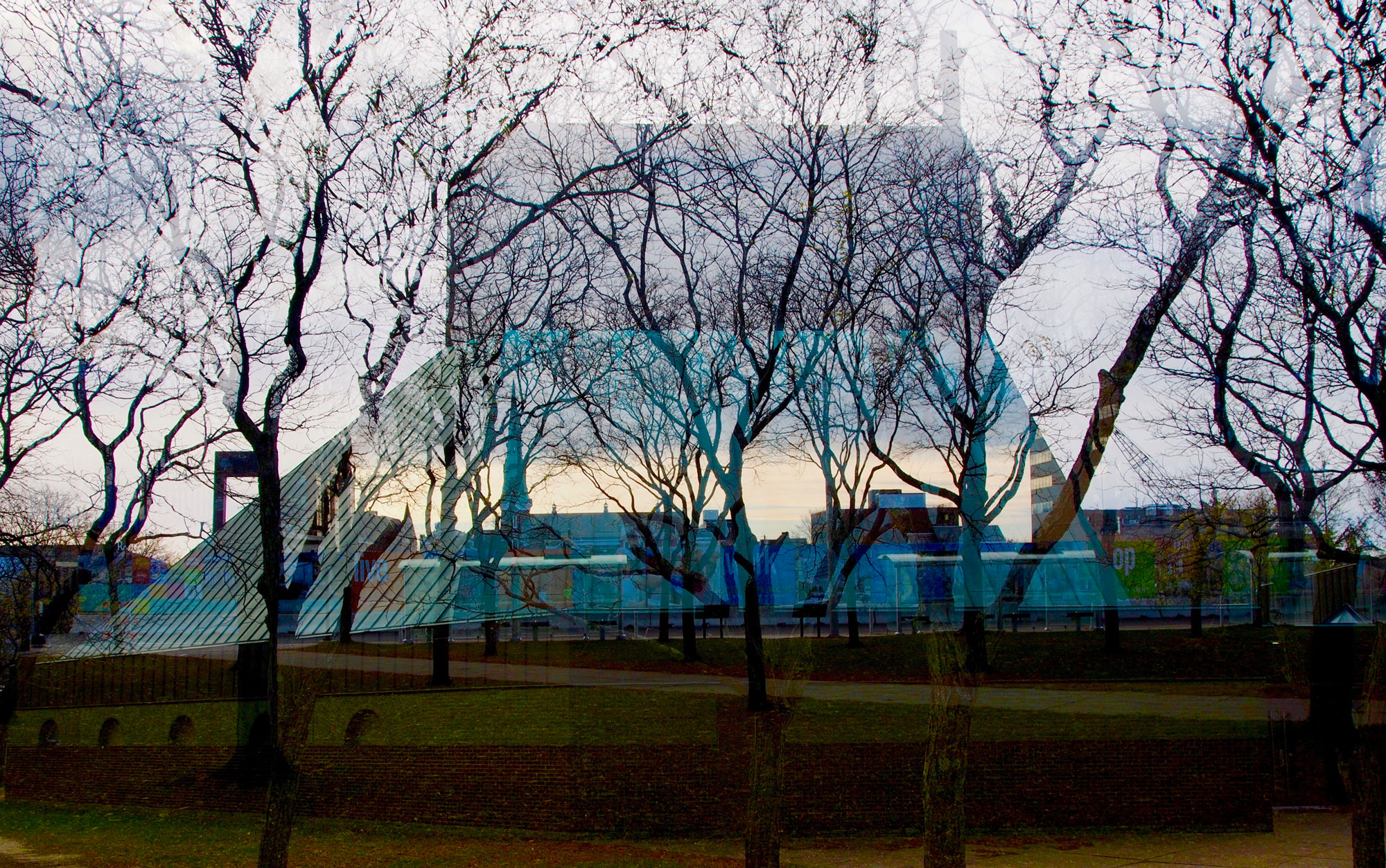 I wish I could elude the anxiety and sadness that seize me on the occasion of virtually every pronouncement of public development policy. Why does each one inevitably appear to me to be misguided, arrogant, destructive, an important opportunity to create and enhance sustainable community frittered away for ignorant, inappropriate and venal purposes ? How do other architects stand it, why do they collaborate ?
I wish I could elude the anxiety and sadness that seize me on the occasion of virtually every pronouncement of public development policy. Why does each one inevitably appear to me to be misguided, arrogant, destructive, an important opportunity to create and enhance sustainable community frittered away for ignorant, inappropriate and venal purposes ? How do other architects stand it, why do they collaborate ?
The Burlington Free Press (sic) of August 10th, 1995 presented a request for proposals, under the auspices of the Burlington Planning Department, for the re-development of the city-owned properties at and adjoining 82 South Winooski Avenue. The redistribution of public assets to private profit ; exactly the reverse, in my opinion, of the entire point of the planning process. But not, in my experience, an exception. The power of the so-called development community seems not to have been significantly diminished by years of progressive administration. If anything it seems to have been enhanced and legitimated. And their singleminded pursuit of profit seems completely untempered, in spite of the rhetoric which sometimes accompanies their activities, by any other concern for the physical, social and cultural fabric of the city. Or, for that matter, for its æconomy. Certainly, with very few exceptions, it is hard to imagine them capable of the kinds of generosity and civic affection that motivated earlier generations of business people to give us the Arms property, the football field at Burlington High School, Battery Park, etc.
So why can’t I just let it be, why haven’t years of disappointments cauterized me to these realities ? The fact is, it’s just too important. Here was a fortuitous opportunity : an almost last chance, if there had been the will, to create some amenities in the center of the city for young people in particular, who have been so badly hurt and will continue to be so badly hurt by the cynical commercialization of the environment, and for all the other residents of Burlington as well. What too many merchants want downtown is clear ; they have promoted their needs vigorously, aggressively, relentlessly : cars, cars, consumers, consumers. And more cars, and more consumers. And fewer costs. Simple ! What the residents of Burlington need downtown is something else, also simple and also significantly more complex : a restoration of green space, oases of quiet, structured and unstructured and perpetually accessible recreational opportunities close to our places of work.
Some of the questions that would need to be asked in the context of an authentic Downtown Development process are obvious and imperative : how do we get stores that stock essential goods instead of stuffed ducks ? how do we create more—and more dignified—occupational opportunity ? where can we accommodate some significant increment to our housing stock, say three to five thousand truly affordable, accessible units with adequate solar access ? If Church Street is Downtown, what are North Winooski Avenue and North Street ? how do we eliminate cars ? how do we enhance pedestrian life ? where shall we put additional “green” space ? It is in that context, in the context of an authentic planning process, rather than through the mechanism of a basement sale, that we should be considering, as a community, the appropriate exploitation of the “central business district”. At the site of the old police station we already own the land and some of the infrastructure—an important building of historic significance, services, communications hardware. And the land is bounded by several non-profit community institutions—the YMCA and the First United methodist Church—both of which could benefit from and contribute to what we need now : an intensive and intensively public process of planning, design and implementation. Paradoxically, the achievement of our merchants’ goals—higher density, more cars, more parking—would tend to preclude the satisfaction of the needs which they would generate : the need for the restoration of green space, more extensive oases of quiet, more structured and unstructured and perpetually accessible recreational opportunities adjacent to our places of work. It is the dialectical resolution of this apparent paradox that the Planning Commission should have been addressing as a prerequisite not only to the more global needs of Downtown but to the specific opportunity for an authentic, equitable, sustainable and broadly æconomic evolution of the two blocks that contain the 82/92 South Winooski properties as well as Burlington Memorial Auditorium, the Fletcher Free Library, the Fire Station, the Main Street Motel and the College Street Congregational Church, the YMCA, the Nickelodeon, the Municipal Parking Lot, the abandoned Police Headquarters and Detectives buildings, the First United Methodist Church and the Funeral “Home”. These two blocks constitute an essential part of the Civic center of Burlington. It has been apparent for some time that they are inappropriately zoned ; the impending re-write of the municipal development plan, the presence of a new comprehensive planner within the Planning Department and the need for closure on the 82/92 South Winooski Avenue properties all suggest that the time for rezoning is now. And a re-zoning of properties fronting on adjoining streets—the South side of Main and the east side of South Union in particular— should probably be considered as well. Consider, for example, the opportunity for expanding services to Memorial Auditorium offered by the building presently occupied by the Telephone company at the corner of Main and South Union, etc. And is zoning all we’re going to do ? Or are we going to engage in an authentic planning process with a commitment to implementation ?
All of this is easy to say, hard to do. It requires political courage, a willingness to look beyond the banal conventions of the livable tourist city, restraint, and luck. But it is absolutely imperative. The response to the RFP elicited the predictable responses, with Antonio Pomerleau’s (surprise !) heading the list. (from 1996)
05401

September 2018 – FREE RADICAL
FRIEDRIKE KEATING
DOUBT IN MEDICINE
LOUIS MANNIE LIONNI
FIRST LOVE
MARJORIE SUSSMAN
CLOSE TO THE LAND
LOUIS MANNIE LIONNI
TWO HOUSES : CROSBY
HART
DAVID SELLERS
MAKING A CONCRETE
HOUSE
LOUIS MANNIE LIONNI
and KEN BURRIS
MANSFIELD PARK
VIRGINIA CANTARELLA
HERMAN
LOUIS MANNIE LIONNI
HOUSE : HARRY HUNT
GEOFFREY W. CRAWFORD
UNCERTAINTY IN THE LAW
GIOVANNI LEONE
IL RIGORE DELLA LIBERTÀ :
GUALTIERO MARCHESI
PIERO RIVOLTA
FIRST LOVE : POETRY
LOUIS MANNIE LIONNI
HOUSE : TRUEX CULLINS
CASEY BLOOD
FAITH IN SCIENCE
LOUIS MANNIE LIONNI
EDOARDO SALTARELLI
September 2018 – FREE RADICAL
LOUIS MANNIE LIONNI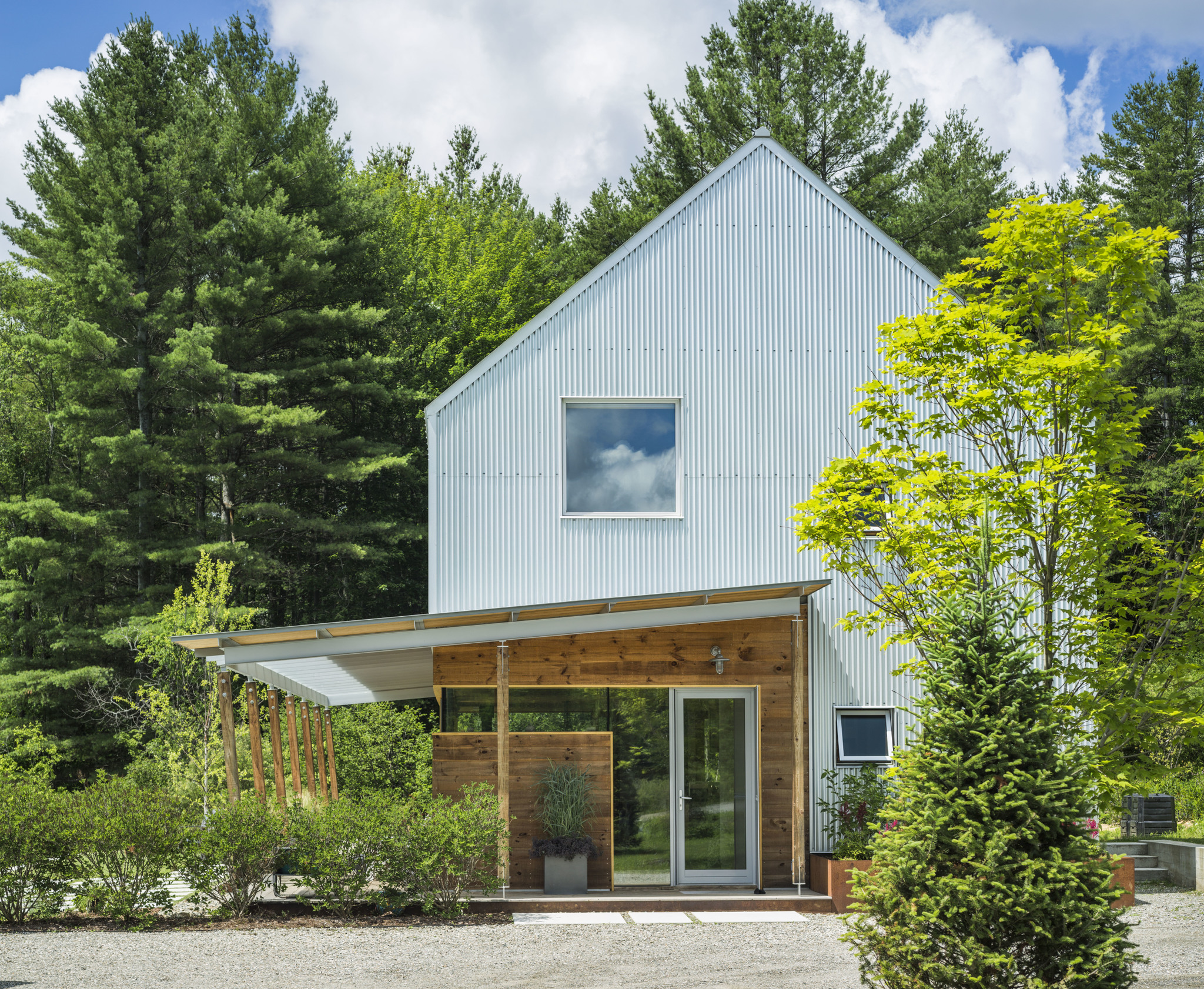
05401—with this issue—begins to move into new territory. Its little sister 05401PLUS has played out its monthly role. It was livelier, more current, younger. 05401 will try to meet it halfway, in the spirit of compromise and collaboration that are so missing from our political life at all levels of government : we’ll publish four times a year, and—without abandoning the personal, pragmatic, romantic and heterogeneous—we will take on local politics more directly. More theoretically, more programmatically.
We are faced with a set of problems, municipal and national, that beg for radical analysis, radical solutions. The established political parties act like established political parties. The needs and the participation of the rest of us are co-opted, ridiculed, trivialized, marginalized.
It’s time to get more serious. ask tougher questions. Organize.
Growth is good ; smaller is better.
Its pretty clear to many of us now that industrialization and its modern counterparts— automation and artificial intelligence—have their own logic, and their own biases. And that left to their own devices they can be, and probably will be, even more destructive than even we are.
Yogi Berra mis-led us. Or the media did. When you come to a fork in the road—at least in this case—it does make a difference which fork we take. Shakespeare, an otherwise trustworty guide, would have had us follow our current path :
There is a tide in the affairs of men.
Which, taken at the flood, leads on to fortune;
Omitted, all the voyage of their life
Is bound in shallows and in miseries.
On such a full sea are we now afloat,
And we must take the current when it serves,
Or lose our ventures.
Did he mean “dentures” ? Was he actually alluding to the Affordable Care Act ?
Even the Mayor and the City Councilors seem to believe that less is more. Demolish the Moran ! Tear down Memorial Auditorium ! Tear up City Hall Park ! Get rid of the hundreds of houses (and the people …) across from the Airport ! Destroy the irreplaceable landscape at what had been the orphanage—and then Burlington College— on North Avenue ! And the demolition of the Catholic Cathedral is just around the corner.
What a resumé !
Perhaps the Mayor—who is so fond of consultants— and the Councilors could share their experience and their prescriptions for the good city with their colleagues in Rome, Italy, whose thirst for “development” is blocked by the debris of centuries. The acqueducts, the Coloseum, Fontana di Trevi just to mention the most obvious. The Colosseum in particular : our administrators could suggest a development team of a couple of inexperienced students and an equally inexperienced older white man, to develop this crumbling eyesore into a mixed-use private- public theme park. A micro brewery, an ice climbing wall, a Farmhouse Group restaurant (how many good American restaurants are there, in Rome ?) and some stuffed lions.
If the Roman voters rejected commercializing this old wreck, it could be demolished, the land privatized and developed as upperincome housing.
Don’t think the Italians haven’t considered this !
Somehow, we have to change the way we think about development. From a purely utilitarian perspective, the administration’s current direction seems appropriate ; but even from a purely utilitarian perspective it’s not. We can’t afford to keep utility and beauty in separate realms. Our city is open to new ideas, but all it gets from the administration are old ones, ideas that have been discredited for half a century, No one seems to be willing to question the urban planning clichés of the nineteen-sixties. Money rules ; the Champlain Parkway continues to crawl along, indifferent to logic, to good practice, to public input, to the times they are a’changing.
By what right do educational institutions build housing for students, but not for the rest of us ? By what right do people of wealth get larger building lots, larger houses, better views, more open space ? By what right do developers get to control—and circumvent— the zoning laws of the city ? Why are residents of the city forced to pay to park on roads which they own ? Why are interactions with the city so unpleasant ?

October 2016 – THE WALL
MARC ESTRIN
CLASSICALLY ABSENT
CHARLES SIMPSON
MEXICAN WALLS
LOUIS MANNIE LIONNI
THE PERMEABLE MEMBRANE
JAMES LOCKRIDGE
BEING NOT LESS THAN LIONS
MICHAEL WISNIEWSKI
PORTFOLIO
PHYLLIS R. ROBINSON
CELL WALLS
SHARYL GREEN
From YOU CAN’T LOCK UP THE
MOON
LOUIS MANNIE LIONNI
CARO MARIO :
LETTER TO MR. BATALI
JOHN FRY
THE HEADWALL 65 YEARS AGO
DIANE GAYER
UNTITLED
PORTFOLIO
LODOVICO MENEGHETTI
MIGRATIONS PAST
AND PRESENT
JOHN SHAPLIN
HADRIAN’S WALL
MARK ESTRIN
THE WALL
October 2016 – THE WALL
APARTHEID WALL
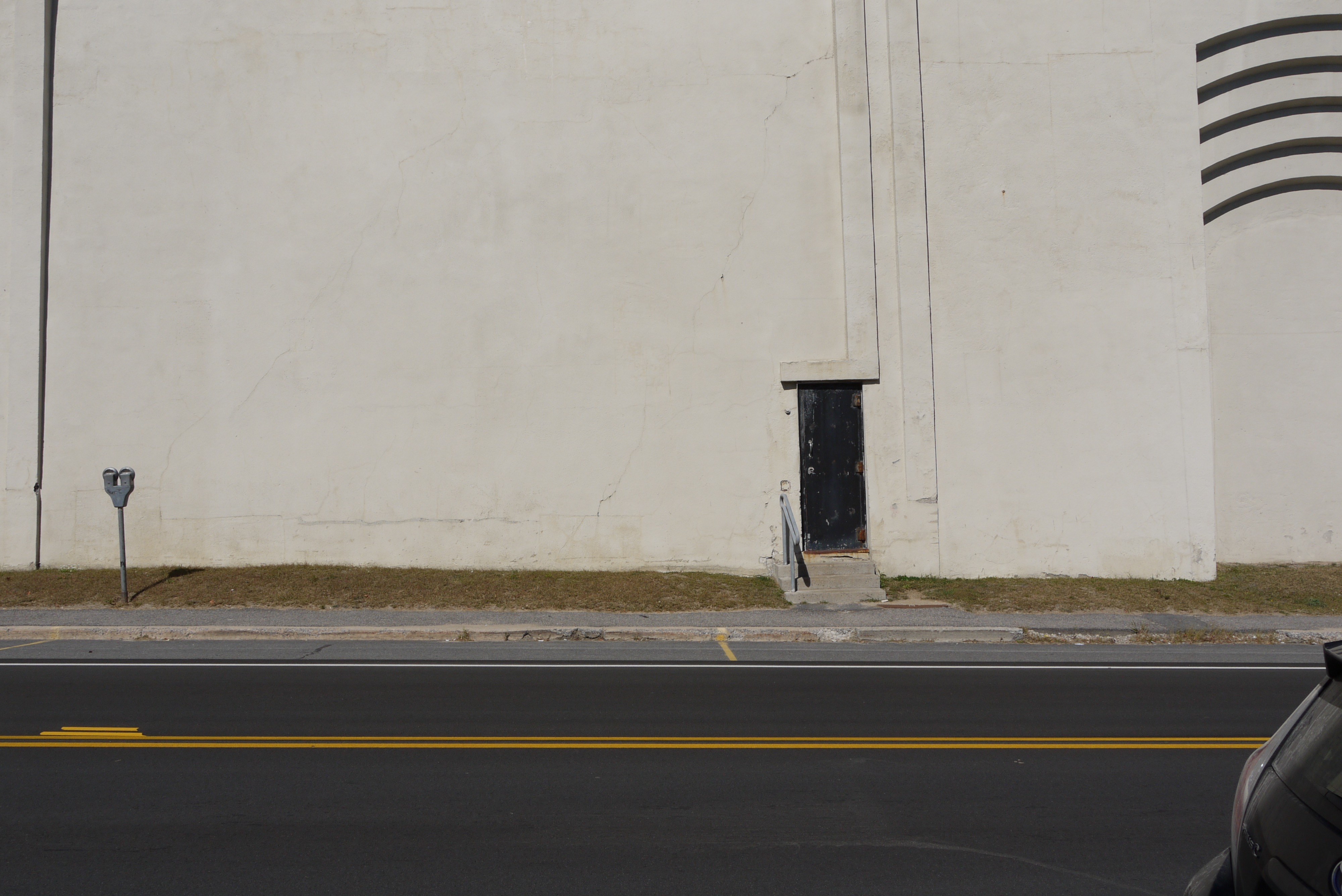
The heads at classical concerts are largely gray, and the wallets that can afford the
tickets are fatter than those of the lumpenproletariat. We on the left spend our music money elsewhere.
But why are lefties so blind, so deaf, to the revolutionary message of “classical” music? Why are highly educated, morally aware, philosophically sophisticated, politically savvy actors so insensitive or oblivious to a millennium of radical expression?
I don’t get it. In “classical” music — from the tenth through the twentieth century — we have inherited a cornucopia of profundities, prompting and announcing social change at every step along the way, educating human consciousness towards ever-greater complexity of perception and thought, coaxing out our emotional and spiritual depths. The great composers have always demanded from us, and developed in us, precisely those sensibilities we need to confront the hugest issues we face — structure, otherness, variation, modulation, time, change, form, dissipation…love.
I think of the room in which the Eroica was first performed — its aristocratic, gold-leafed curlicues, its elaborately carved chairs. I think of Beethoven’s assessment of the “princely rabble” that would seat their asses on those chairs, and the shattering indictment with which he would assault them in the name of freedom. Seid umschlungen, Millionen, he intoned in the Ninth Symphony, masses embracing in the kiss of the entire world. Tell it to Obama, Hillary, Trump and the IMF. Bach’s intensity and structural investigations, Brahms’s sexuality unlimited, Mahler’s catalogue of hetero-interactions, Wagner’s engorging instability, Bartok’s mesto dance, Stravinsky’s primordial landscapes, Berg’s evocation of interstitial states — one could go on and on, and in and in. Are all these irrelevant to the left, and to our goals of head and heart?
Let’s talk about the means of production. Though there are surely classical stars and consumers, by far the greatest number of sounds are made by amateurs at choral or orchestral or chamber music rehearsals and performances, or playing at home — a democratic, participatory picture of growth, education, and community, growing since the eighteenth century.
Yes, pop and ethnic, hip-hop and metal speak strongly to us. But they are not the only music relevant to the left. We need to recover the largesse of our musical heritage, and continue to grow from it if we are ever to be able to confront our times.
MARC ESTRIN
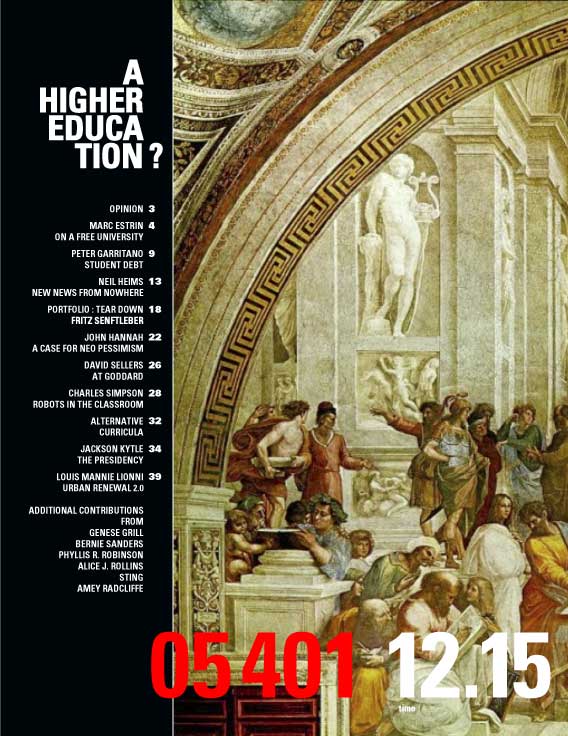
December 2015 – A HIGHER EDUCATION
MARC ESTRIN
ON A FREE UNIVERSITY
PETER GARRITANO
STUDENT DEBT
NEIL HEIMS
NEW NEWS FROM NOWHERE
PORTFOLIO : TEAR DOWN
FRITZ SENFTLEBER
JOHN HANNAH
A CASE FOR NEO PESSIMISM
DAVID SELLERS
AT GODDARD
CHARLES SIMPSON
ROBOTS IN THE CLASSROOM
ALTERNATIVE
CURRICULA
JACKSON KYTLE
THE PRESIDENCY
LOUIS MANNIE LIONNI
URBAN RENEWAL 2.0
ADDITIONAL CONTRIBUTIONS
FROM
GENESE GRILL
BERNIE SANDERS
PHYLLIS R. ROBINSON
ALICE J. ROLLINS
STING
AMEY RADCLIFFE
December 2015 – A HIGHER EDUCATION
LOUIS MANNIE LIONNI
Higher Education is unImaginative, unAffordable, unAccessible, unDemocratic, and all too conventional, an integral part of the national dysfunctionality.

Carl Marx was wrong. He thought critically,
but he was wrong. He thought the revolution
would start among the urban proletariat
of one of the more industrialized countries ;
but it started – and, for some historians,
ended – in feudal Russia. 1960s radicals
foresaw a revolution that didn’t happen.
Their politics, their critique, their way of
thinking and their analysis are out-of-date,
“démodé”, out of fashion. But fortyfive
years after 1968 the potential for revolution
is greater than ever.
The purpose of higher education is to complete
the process by which we give younger
generations – or help them achieve, depending
on your didactic point of view – adequate
tools for independent (but also “collective”)
critical thinking. Anything else is
our failure. Critical thinking is a prerequisite
for effective action, whether it be real estate
development or early childhood development,
or aid to developing countries or the
development of a revolutionary consciousness.
A critical analysis of the material – and
immaterial – reality in our country suggests
that the potential for revolution is very high ;
(only) the sources and outcomes are
unknown. But they are not unknowable.
Statistically, the chances are very high that
the revolution will take one of two forms :
1. A military coup formalizes and institutionalizes
undemocratic processes which are
already at work in our communities, and
replaces our present government (or perhaps
it is our present government…).
2. A popular insurrection by all those of us
who are being landfilled by the system we
call (but it’s a mystification of what’s really
going on) capitalism, which means 80% of
us.
The success of the first of these two possibilities
depends on the speed and the extent
of the militarization which is taking place.
The speed is critical ; at some point we are
all – even those of us who support the imperial
missions of the military – going to realize
that the development of electronic
surveillance and weapons delivery systems
is not intended to protect American lives
from “harm’s way” abroad, but to protect
the privileges of the ruling class here at
home. The “spinoff” of military R&D no
longer serves a peaceful purpose ; but it will
make it un-necessary to recruit fodder for an
unpopular domestic war. So will our fear of
revolution, fed by massive media campaigns
and other assorted tactics, prevent
us from organizing the second revolution to
defeat the first ? That’s an experimental
question.
The essays in this issue of 05401 reflect on
the nature of higher education, its potential
and its problems. But many of those problems,
and the limits of that potential, come
from the control of higher education.
Who controls higher education ? For what
purpose ? To what end ?
In Burlington higher education is a big deal.
So why don’t we have a municipal College ?
Why is higher education considered of a different
kind from 1 – 12 ? Isn’t it time to take
our responsibility to our children, our
friends’ children, all of Burlington’s children
up a notch ? 1 to 16 ? Free education has
been on a growing curve since its inception,
and Bernie’s campaign for Free College
Education at the national level should stimulate
us to provide it at the local level, under
local control. Community control may seem
like a quaint idea at a time when our local
police are controlled by the military. More
and more, at an accelerating rate, we are
losing control of our local economy, our
municipal elections, the growth and the sustainability
of our city, the quality of our environment
and the quality of our lives.
Who’s to blame ? We all have our theories.
But in the face of the accelerating privatization
of everything, Burlington has a chance
to expand the opportunities it offers our
young people by encouraging Burlington
College to truly become the College of
Burlington. For decades the College of the
City of New York provided free higher education
to all of its residents, and benefited
from the transformation of a vast stream of
immigrants into a priceless, productive
resource. Burlington is poised to do the
same for its own wave of immigrants, albeit
at a smaller scale.
Elsewhere in the country Public Universities
are going private. We have a chance to go
our own way. The benefit to Burlington
College ? The actualization of its mission.
the support of its community,
Just an idea.
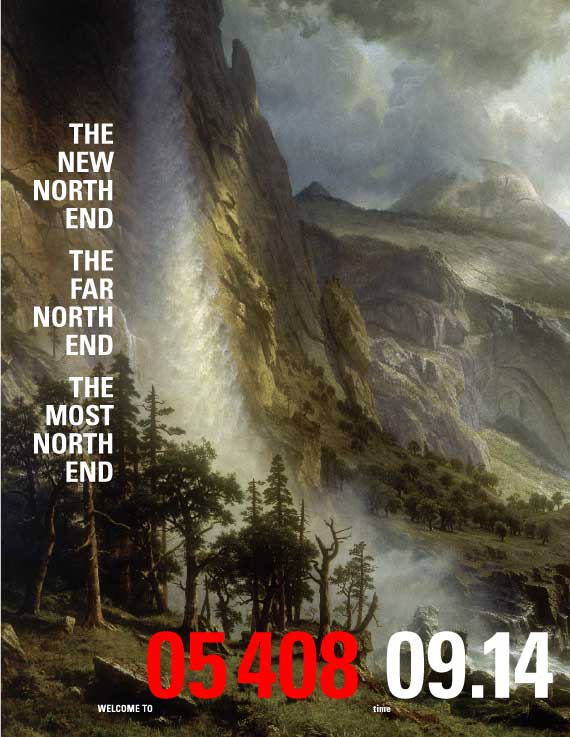
September 2014 – THE NEW NORTH END, THE FAR NORTH END and THE MOST NORTH END
NORTH NORTH, FAR NORTH, MOST NORTH
Diane Gayer, Sally Linder Ruby Perry and Andy Simon
MI RICORDO
Louis Mannie Lionni
STEALTH
Loiuis Mannie Lionni
PORTFOLIO
Carolyn Bates and Nick Hadsel-Mares
THE SECOND BANK OF THE UNITED STATES IN OUR TOWN
Jane Knodell
STASIS AND CON VERGENCE CHARAC TERIZE MORPHO LOGICAL EVOLUTION IN EUPOLY POD II FERNS
Michael A. Sundue and Carl J. Rothfels
SYNTHETIC VERMONT
Charles Simpson
COUNTER ATTACK : DEVELOPMENT 1,2,3,4
Louis Mannie Lionni
A RENEWABLE ENERGY FUTURE FOR VERMONT ?
Brian Tokar SKIN AND BONES Rolf Kielman
September 2014 – THE NEW NORTH END, THE FAR NORTH END and THE MOST NORTH END
The New North End, the Northeast Kingdom and the Arctic are all threatened by development. Many of us understand that endless growth is not desirable, not even possible, but individually, or as communities of place or of interest, we pretend that we can continue to develop as we always have. Littering is bad, but if I litter how much of a difference can that make ? Voting is good but who ever won an election by one vote ? Recycling ? Sure, but it will work whether I participate or not. And one more building, or the derfoliation of one more landscape, or the transformation of one more ridgeline, or adding a few dozen decibels to the cacophany of our lives, how much of a real difference can that make to the future of the Planet ? This issue of 05401 tries to address these questions. The New North End is facing several threats to its integrity, its history, its diversity. And in each case – the COTS proposal to enlarge their building on North Avenue, Burlington College’s plan to sell off its landscape for affordable and non-affordable housing, and the plan to put a large array of solar panels in the center of the Appletree Point residential community – old allies in the struggles for affordable housing and environmental justice and sustainable energy are finding themselves in opposition.
Long histories of friendship are being obliterated by apparently irresolvable disagreements. In the Northeast Kingdom the issues are larger, and the conflict more bitter. Eco environmentalists are worried about the corporate threats to our landscape and our health exemplified by developments – the pipeline, wind turbines on the ridgelines – which techno environmentalists see as essential to our survival. And in the Arctic, seemingly so far removed, national ambitions and commercial interests are colliding at the expense of a vast social and environmental eco-system and placing the entire planet at risk ; at issue are natural resources and the natural environment, but also geopolitical advantage, that out-of-date nationalism that we’ve come to know so well.
The survival of the planet doesn’t hinge on the fate of a piece of urban landscape in a small town. But it’s unlikely that the planet wil survive unless we take responsibility for it at the local level. Burlington has a tradition of political and social progressivism ; during the Mayoral tenure of Bernie Sanders the environmental movement reclaimed the eco-logic of our city from the urtban developers of the sixties and the party politics of forever. Now we are back to square one. II. The recent municip[al elections gave both the Mayor and the City Council an opportunity to fuck over the electorate, and the electorate acquiesced. It could be seen as rape, but the Mayor and the Councilors would probably describe it as consensual sex. 5,000 voted for the TIF and the Charter changes. 15,000 registered voters didn’t., Nor did the other 20,000 residents of Burlington. Consensus ? All in all, it took only a tenth of the residents of Burlington to give the Mayor and the Councilors what they wanted. As in elections past, the failure of the majority of even registered voters to come to the polls has been written off to indifference ; but in fact it is due to justifiable alienation from the entire political system. Until a political coalition begins to listen carefully to that portion of the electorate many Burlington residents will continue to be the victims of the process that brought us Urban Renewal in the sixties and PlanBTV in our own time.
We need to organize around these issues.
The TIF vote was conducted under the cynical threat of the demolition of the Moran. And voters were asked to support a redistricting plan that was cobbled together by the Council against the best advice of representatives of all the NPAs. The objectives of the redistricting proposal were not simply fair and equal representation ; they were first and foremost a move to emasculate Republican representation in the New North End and to marginalize – and neutralize – the students who live at the top of the Hill, the fastest growing segment of our population.
We need to organize around these issues. Bernie Sanders won the Mayoral race in 1980 because he was able to identify – and identify with – groups of residents who, up to that time, had been ignored by the two major parties : the elderly, the poor, the young, the students among others. Many of them had been the victims of urban renewal, others of benign neglect. The present Mayor’s election represents one step back for progressive politics. Hopefully, it will be a short prelude to two steps forward.
LOUIS MANNIE LIONNI

July 2013 – WHAT A RIOT !
PROGRESSIVISM
Greg Guma
NATIVISM
Michael Watson
IN TIMES OF CRISIS
William J. Mathis
MODERNISM
Mark Baumgartner
ANARCHISM
Cindy Milstein
SOCIAL ECOLOGY
Dan Chodorkoff
MURRAY
Janet Biehl
FUTURISM
Ted Montgomery
DIALECTICAL MATERIALISM
Mario Maffi
PACIFISM
Ruah Swennerfelt
ARRIVAL IN SAWNA
Robert Nichols
AND : Ralph Culver Dore Ashton Anna Blackmer Vic Cestnutt Joan Baez Michael Wisniewski Eeva Kilpi Elio V. Bartoluzzi
July 2013 – WHAT A RIOT !
Take a really good hard look at the photos of Police aiming their rifles at the children of Burlington, the young people who are expressing their legitimate despair over the direction that their country is taking on so many fronts. Is it unreasonable to suppose that soon your children – and even you – will be facing those rifles ? For many of us, just a few years ago, it would have seemed absurd, unthinkable. Now, I’m not so sure.

January 2012 – We’re still alive
OPINION
Louis Mannie Lionni
THIS OPEL HOUSE
Louis Mannie Lionni
PORTFOLIO
New Work in Burlington
LETTERS TO THE EDITOR
Sandra Baird, Pippo Lionni
THE OBITUARIES
Barbara Zucker
EMILE ALLAIS
Bob Soden
MICHELLE HAMER
Helene Frichot
PORTFOLIO
Further Afield
TRADIZIONE E INNOVAZIONE
Gualtiero Marchesi
LAST CHANCE
Anne Rothwell
AND :
John Wesley Harding Buffalo Springfield Emile Allais William Shakespeare
January 2012 – We’re still alive
LOUIS MANNIE LIONNI
The demise of the Progressive Party in Burlington leaves us with two options : back to the old old of Republicans and Democrats, or forward to a more substantial, more radical, more innovative politics of the left. If you share Greg Guma’s assessment of Progressive Politics (05 401 12 10) in Burlington during the years of its ascendency and virtual hegemony on the socio-political life of our city then you can’t be surprised that – thirty years after its inception – it has devolved to the struggles of a Mayor to hold on to the last remnants of dignity as he, and what’s left of his party, prepare to leave the scene definitively.
A Republi-crat counter-revolution is not out of the question. Thirty years ago those two parties had squandered the political legacy of Conservative politics and Reform politics ; thirty years later they are even less relevant to the evolving needs of the city. Which is not, as my friend Julian Cohen would say, to say that they aren’t trying. And there will be an electorate attracted to the mirage of going back to (you pick it) economic responsibility, smaller government, lower taxes, less regulation, etc etc etc. But the real question is whether – and how – we will move forward to take on the real challenges of our time : an evolving and diversifying ethnicity and the dramatic implications of a politics of diversity ; a growing disparity between rich and poor ; the threat of radical right wing religious doctrines on the institutions of municipal government ; alternatives to the inequities of free-market practices in the work-place, housing, medical care, business, education ; the adaptive imperatives of an antiquated urban infrastructure – old forms of transportation, energy generation and distribution, housing construction ; the protection and expansion of natural resources, the de-Disney-fication of the waterfront ; and, most importantly and most problematically, overcoming the arbitrary divisions of the larger Lake Champlain Basin eco-region into separate State and Municipal jurisdictions.
The elections are shaping up once again to defy our innocent belief in the diversity of opportunity in our fair city. Bernie Sanders, in his first years as mayor, was a fresh voice addressing a disadvantaged constituency : the poor, the elderly, the young and – with the exception of his advocacy of the Alden plan – our environment. And he brought prosperity to the middle aged and the middle class, a vivid example of trickle-up economics. Peter Clavelle followed Bernie with a more modest ambition and a more managerial disposition. Bob Kiss replaced Peter with apparently no ambition and a quiet, opaque, old-fashioned political style ; we got Burlington Telecom, we almost got Lockheed Martin (we may yet) and we’re on the verge of yet another Moran Plant fiasco. And with the pretext of law and order we got the eviction of the opponents of the collusion between government and financial and corporate greed from City Hall Park.
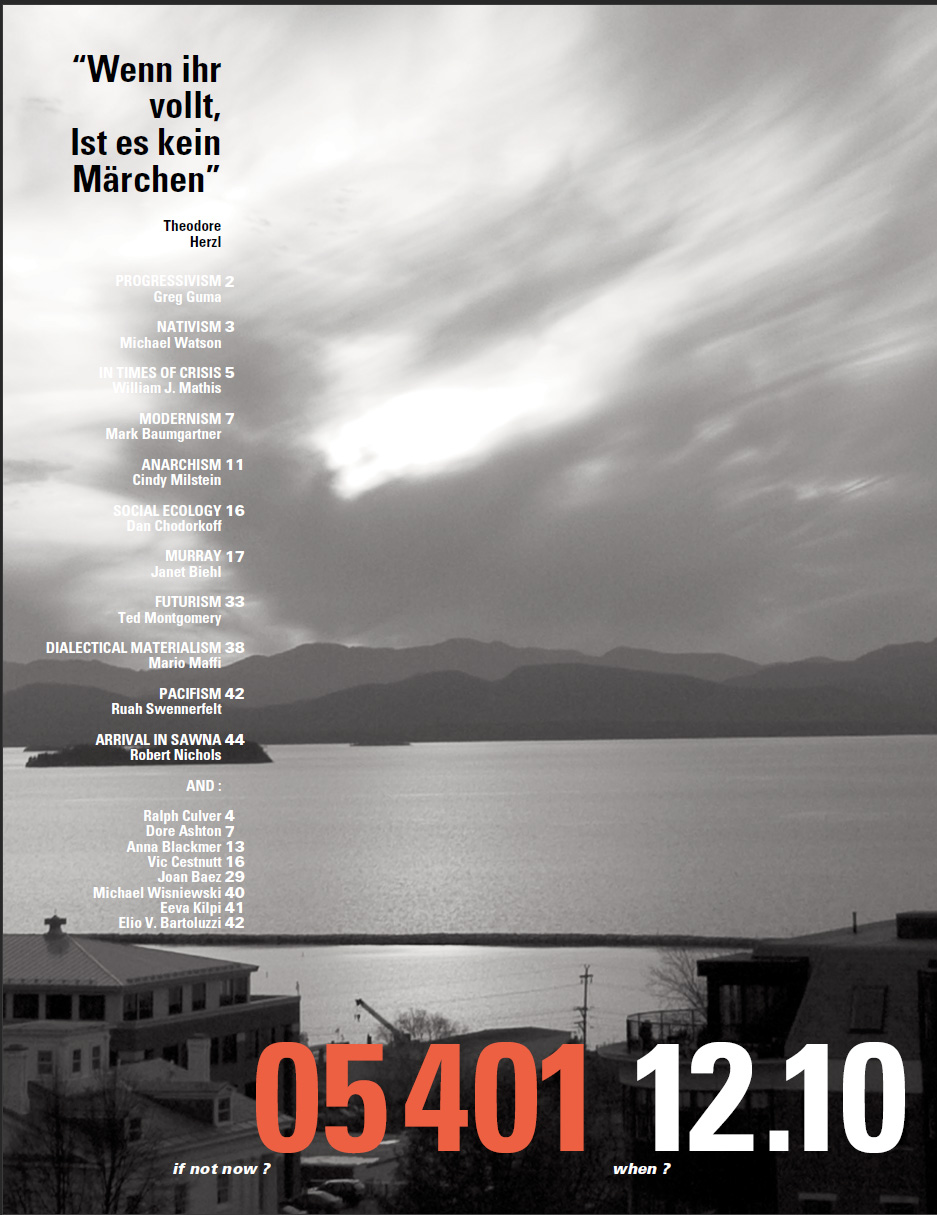
December 2010 – the ISM Issue
PROGRESSIVISM
Greg Guma
NATIVISM
Michael Watson
IN TIMES OF CRISIS
William J. Mathis
MODERNISM
Mark Baumgartner
ANARCHISM
Cindy Milstein
SOCIAL ECOLOGY
Dan Chodorkoff
MURRAY
Janet Biehl
FUTURISM
Ted Montgomery
DIALECTICAL MATERIALISM
Mario Maffi
PACIFISM
Ruah Swennerfelt
ARRIVAL IN SAWNA
Robert Nichols
AND : Ralph Culver Dore Ashton Anna Blackmer Vic Cestnutt Joan Baez Michael Wisniewski Eeva Kilpi Elio V. Bartoluzzi
December 2010 – the ISM Issue
1989 : The Progressive surge of the past decade has brought to Vermont a new, expanded definition of the role of the city. This surge has spilled well beyond Burlington’s borders to change the balance of political power and the nature of debate statewide. And yet there are still unmet challenges, problems not yet solved or even fully addressed by the new Progressives. Thorny questions about growth, the future of an endangered environment, the shift toward a postindustrial society, the rights of women and minorities, and the implications of economic conversion as well as economic democracy lie ahead for Vermont and the nation. Profound and crucial, they await answers from another progressive revolution.
2010 : The heart of the nation’s progressive movement in the early 20th century was an attempt to control concentrated wealth and widen democratic participation. For a quarter century, reforms addressed workers’ rights, monopoly excesses, political corruption, uncontrolled development, and the devastating impacts of the early industrial era. Yet, most of the efforts quelled popular discontent rather than producing basic changes. The resulting reforms were mainly co-opted by business groups to serve their own long-range interests. Rather than leading the country toward some form of social transformation, early progressivism ended up heading it off.
In the process, many people did get relief from the worst effects of uncontrolled capitalism, a considerable accomplishment. The same can be said of the recent progressive era in Burlington and, by extension, Vermont. But the price of the bargain has been high. In the birthplace of Vermont progressivism, it has led to commercial homogenization, environmental triage, and the continued commodification of housing and other resources. The attempt to balance “sustainability” with a pragmatic acceptance of market forces assumes that an economic system based on continuous growth and profitability can be effectively harnessed to serve human needs and respect the natural world. If that has happened, it is capitalism’s best kept secret.
Postscript: Thinking Globally
Stopping corporate rip offs may sound ambitious enough. But as Bernie Sanders has stressed, the underlying issue is how to make powerful institutions accountable – and to whom. Following the logic of progressivism, real change thus involves, at the very least, a stronger role for government. But if the goal is to control mega-corporations that transcend national boundaries – in fact, they already compete with some national governments and dominate others – in the end even federal reform won’t cut it.
Progressives obviously don’t want institutions like the World Trade Organization to run the world economy. But what’s the alternative? The free market, regulated or not? If you still think that option sounds viable, consider most underdeveloped countries or the US economy’s recent crash. Will job creation, stronger enforcement and more accountability really be enough, or does the current international dis-order need to be overhauled and replaced? And if so, with what?
The United Nations could be made stronger, but this Cold War creation was flawed from the start, and has been marginalized and manipulated for more than half a century. The times seem to cry out for more radical ideas, maybe even something like a global parliament somehow linked to communities. This may sound utopian at the moment, but if the Corporate World Order inflicts much more damage it may start to look pretty attractive. And if social and economic justice are truly the driving forces of progressive politics, how far is it to an agenda for change that fundamentally challenges market control and links the global with the local? After all, one of the movement’s favorite slogans is “Think Globally, Act Locally.”
But that’s another story, and not currently on the radar of most progressives, in Vermont or almost anywhere else. Greg Guma is Journalist, author, raconteur, former Pacifica Radio ED & Editor of Toward Freedom, VT Guardian, Vanguard Press, Public Occurrence and Vintage. Visit his blog at : MaverickMedia.com
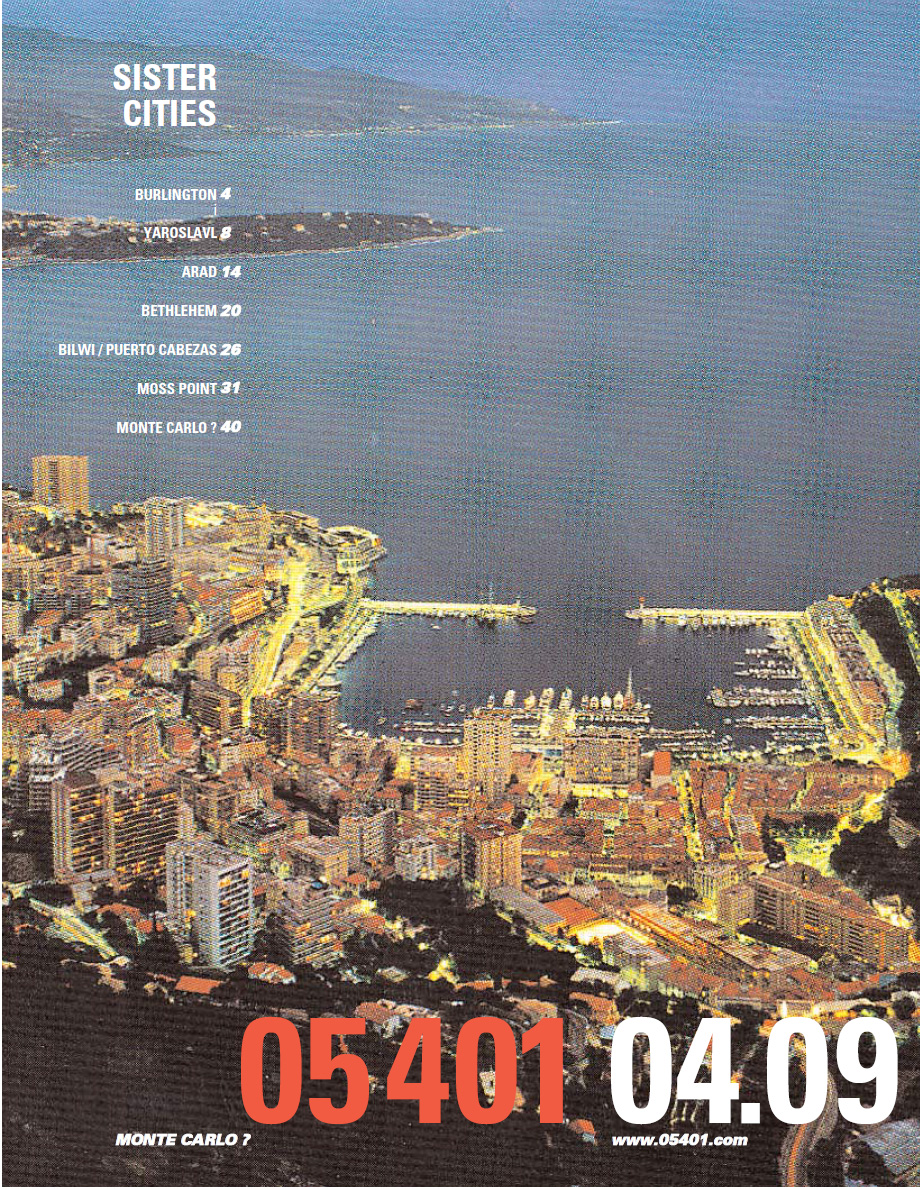
April 2009 – Sister Cities
SISTER CITIES EDITORIAL Sandra Baird
BURLINGTON
YAROSLAVL
ARAD
BETHLEHEM
BLIWI / PUERTO CABEZAS
MOSS POINT
MONTE CARLO ?
April 2009 – Sister Cities
Sandra Baird Nation states with their perverse grudges, competitions, nationalisms and racisms, take us to war; we want peace. In the terrible 20th century nation-states and empires embroiled us in two devastating, global conflicts : in a cold war that often became hot between the United States and the Union of Soviet Socialist Republics and in a treacherous arms race involving weapons of mass destruction. Democratic and authoritarian governments alike ordered their populations to fight and die, to become hardened warriors and to destroy nature for all time. In an era of endless war, the City of Burlington took foreign policy matters into its own hands and made peace with its nation’s enemies. Burlington initiated a sister city strategy, forming companionate relationships with cities in the nations or areas targeted by the administrations in Washington as “evil empires” or “terrorists” or “axis of evil.” At the height of the Cold War, Burlington reached out to Yaroslavl in Russia ; in the early 1980s, when Ronald Reagan declared a secret war against the legal government of Nicaragua and funded the Contras to overthrow the Sandanistas, Burlington formed a sister city agreement with a largely native American population in Puerto Cabazas, a small city on the east coast of Nicaragua ; in 1991, in the most contentious of its Sister Cities initiatives, Burlington responded to the endless discussions of peace prospects in the Middle East by signing a tri-partite agreement of friendship and sororal ties with Arad in Israel and Bethlehem in Palestine.
Recently, Burlington sistered with Moss Point, a city with a largely African American population, devastated by Hurricane Katrina and virtually abandoned by Washington.
Burlington’s peace strategy has been influenced by a small but vital international movement. Known as “Détente from Below,” the movement is informed by anarchist thought and developed by peace activist Joann Landry. Advocates of this movement argue that while families, tribes, religions and city states have always warred, the growth of nation states in the 19th and 20th century in Europe and North America has brought new, horrifying worldwide conflict and destruction of life in its wake. In those 200 years the world has witnessed the consolidation of national governments based on borders, language, race, ethnicity and ideology and the relentless and seemingly inevitable incursion of those states into less developed, more vulnerable areas of the globe. The Sister City strategy recognizes the truth of the Détente from Below argument : the agendas of nationstates seldom coincide with those of their citizens. Men and women find themselves governed and manipulated from above. The Sister City strategy recognizes that beneath the reality of police forces, borders, boundaries, check points, taxation authorities, armies, federal authorities and nationalistic and racial slogans live real people who in nation after nation are not much different from each other and who long for peace. Though we may differ in custom, tradition, religion, dress, and political and economic systems, we all desire healthy, meaningful, beautiful, free and long lives for ourselves and our children. Underneath the violence of our states we can make peace with each other as our governments continue to make war.
Burlington’s Sister City program, along with similar movements like the Women’s March for Peace in Northern Ireland, are dedicated to raising the world’s consciousness of the possibility of a world without war, a world in which men and women in neighborhoods, communities, towns, villages and cities withdraw their consent from the belligerent intentions of their nation states and join together to forge a durable peace.
Sandy Baird, a Franco Scottish – formerly Catholic – American Anarchist is distrustful of national governments and has been obsessed with the peace process in the Middle East. She advocates a policy of “détente from below,” of bypassing national governments and waging peace at a grassroots level
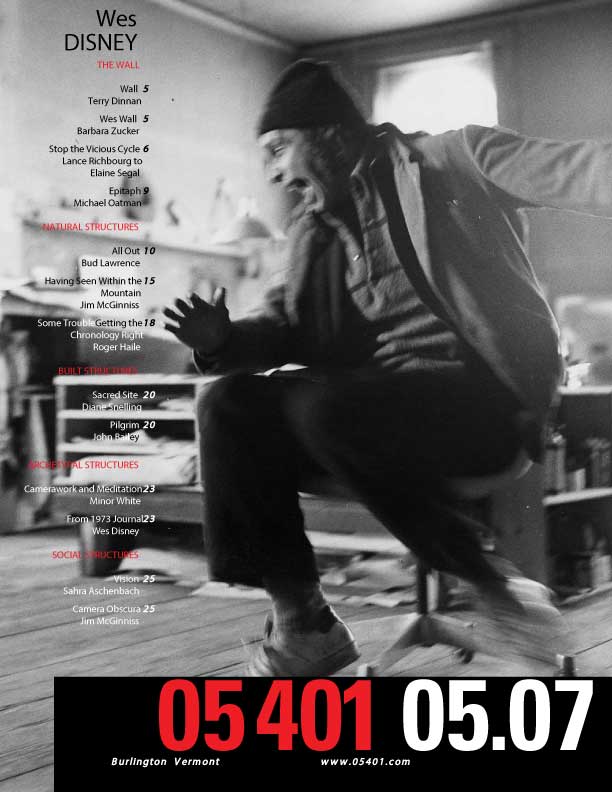
May 2007 – Wes Disney
Wes Disney Editorial AuthorLouis Mannie Lionni Wes Terry Dinnan Wes Wall Barbara Zucker Stop the Vicious Cycle Lance Richbourg to Elaine Segal Epitaph Michael Oatman All Out Bud Lawrence Having Seen Within the Mountain Jim McGinniss Some Trouble Getting the Chronology Right Roger Haile Sacred Site Diane Snelling Pilgrim Jon Bailey Camerawork and Meditation Minior White From 1973 Journal Wes Disney Vision Sahra Aschenbach Camera Obscura Jim McGinniss
May 2007 – Wes Disney
This issue of 05401 is about Wes Disney. It is also about art, the impact it has on our lives, the agencies through which it operates. We document Wes Disney’s artistic persona not only to pay homage to him and to his influence on our community, but also to an alternative lifestyle. It may not be for you or for me, but it serves to remind us that our own lifestyle choices, whichever they may be, are not the only possible ones. We face crises in governance, economics, civil liberties, energy and social policy ; many indicators suggest that for our grandchildren the resolution of these crises will necessarily mean alternative values and alternative lifestyles.
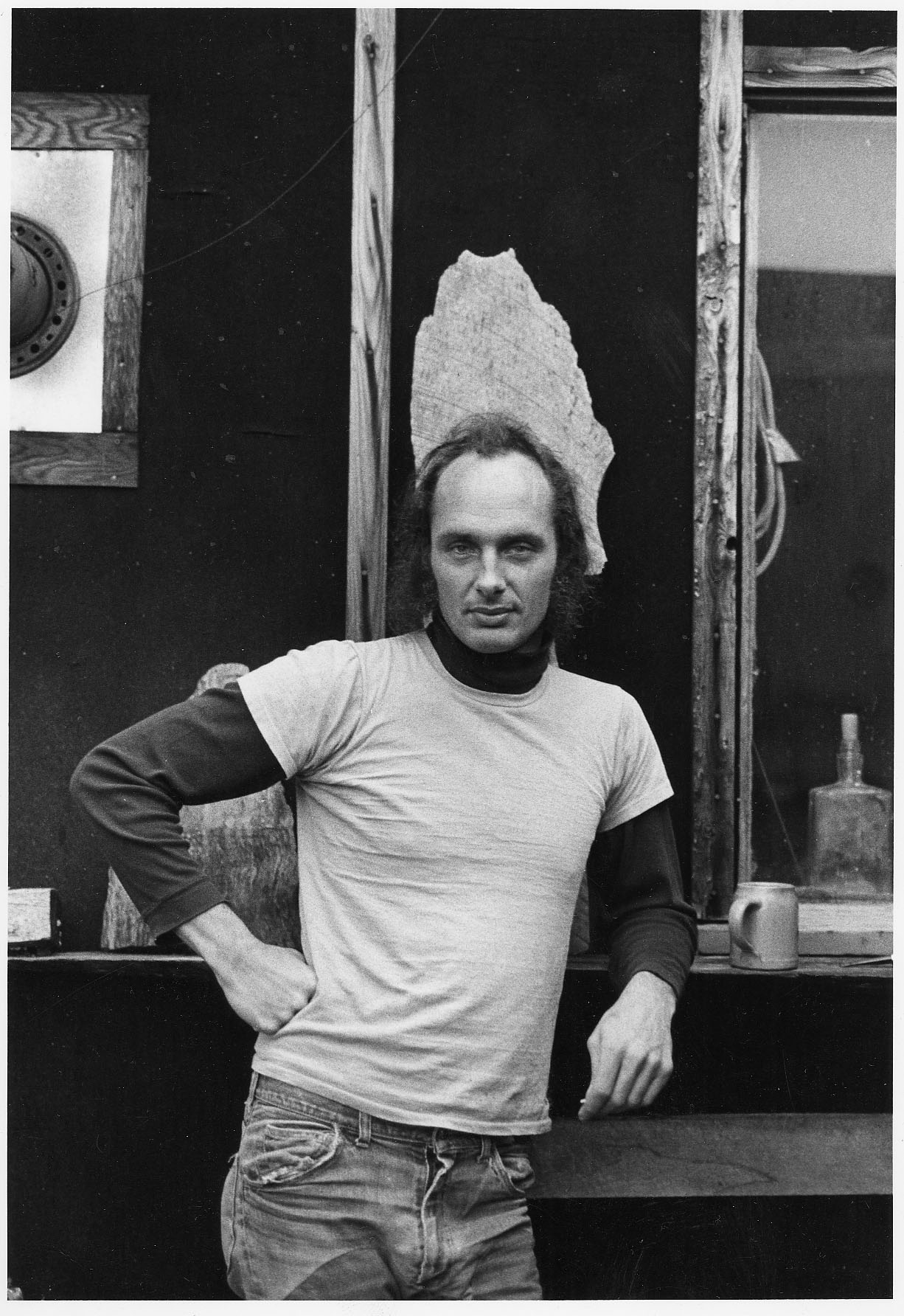
Wes Disney’s personal and artistic legacy should remind us that art is the collective business of community. Vermont does not have a long artistic tradition ; it is measured in decades, not millennia. A commitment to making art in Vermont is not like a commitment to making bagels, or furniture, or snowboards, or money. Burlington might — and does — choose to foster art as a sustainability issue, but so far art is not — with few exceptions — a sustainable lifestyle choice, even though its benefits to the community are clear, demonstrable. Art is the business of the entire community in our homes, in our schools, even in our streets. Through art we honor our most ancient, expressive traditions. And art informs our other cultural traditions : food, shelter, clothing (the domestic economies) and the sciences.
All of the photographs reproduced in this issue of 05401 have been altered, re-sized and cropped. They are printed on papers and with inks that differ from the originals. This is a magazine, and these are its limitations. But the goal has been to represent the variety of Wes?s photographic interests and to preserve the essence of each image in those cases where it would be lost in a necessarily reduced format.
Wes’s own attitude with respect to the permanence and inalterability of his work is paraphrased on page 9 by Lance Richbourg : “Wes was pleased to observe that no graffiti defaced the Wall even though there were graffiti on neighboring walls. He considered this evidence of respect. It then occurred to him that he should deface the Wall himself. He considered writing “Stop the Vicious Cycle” in spray paint high on the Wall, out of human reach. He didn’t identify any particular cycle. The Wall did not outlast Wes, as he once predicted it would ; instead, it vanished before the artist got around to desecrating it himself.” Paradoxically, in my own mind, of all of the art commissioned on the occasion of the construction of the Church Street Market-place, Wes’s WalI, in spite of its evanescent quality and its short life, is the most enduring.
Not everyone was thrilled by Wes Disney’sWall. But not everyone is thrilled about the Iraq war, or the skyrocketing deficit or the continuing and increasing inequalities in the world. What the Wall shared with the war, the deficit and the inequalities is their compelling presence in our lives, their in-your-face-edness. If art is not at the very center of our social dialogue, its impact is nevertheless significant and controversial and deserves our careful, informed, sustained attention.
Louis Mannie Lionni
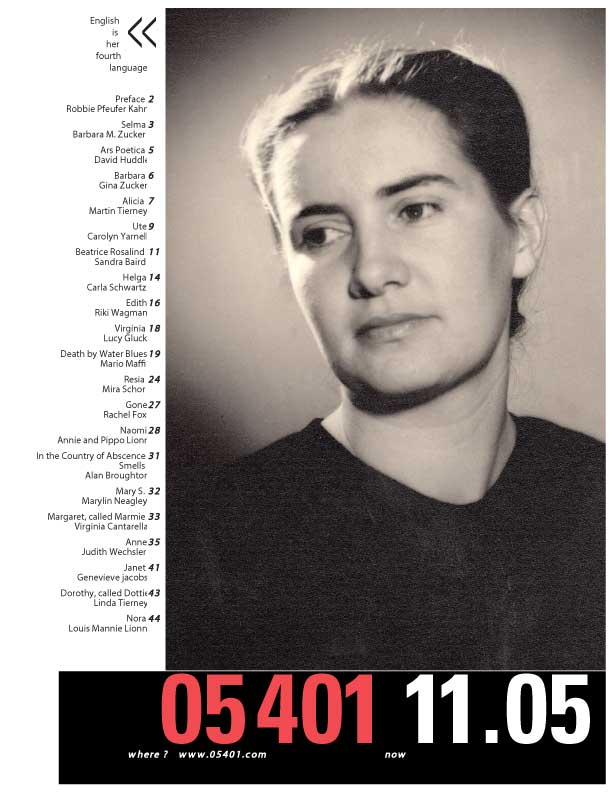
November 2005 – My Mother
Preface Robbie Pfeufer Kahn
Ars Poetica David Huddle Alicia Martin Tierney Beatrice Rosalind Sandra Baird Helga Carla Schwartz Virginia Lucy Gluck Resia Mira Schor Gone Rachel Fox Selma Barbara M. Zucker Barbara Gina Zucker Ute CArolyn Yarnell Death by Water Blues Mario Maffi Naomi Annie and Pippo Lionni In the Country of Absence ; Smells Alan Broughton Mary Marilyn Neagley Margaret, called Marmie Virginia Cantarella Anne Judith Wechsler Janet Genevieve Jacobs Dorothy, called Dottie Linda Tierney Nora Louis Mannie Lionni
November 2005 – My Mother
“I’m not going,” she said as she looked at me. “I’m afraid you are,” Dr. Herzog persisted calmly.”
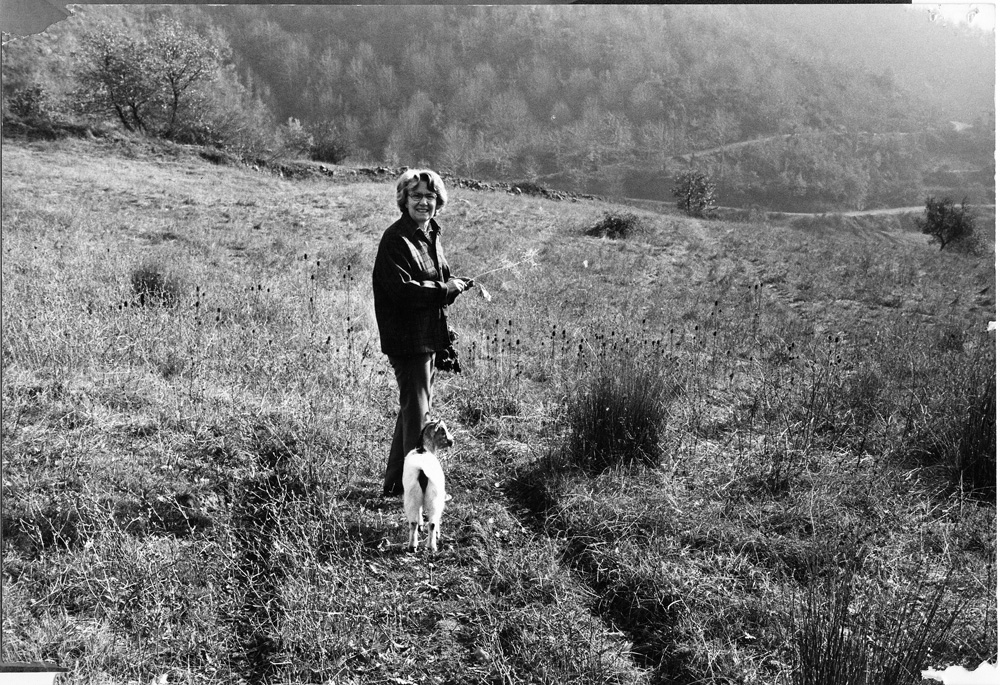
“I’m not going, and that’s that!” she countered with her usual arrogant uppity self righteousness! and now she was out to do it again as we were sitting in Dr. Herzog’s office listening to him ringing her death knoll as I was suddenly seized by a surge of almost uncontrollable rage toward her … suddenly… as I was listening to Dr Herzog spelling it all out, the whole terrible story, I was overcome surprisingly by pure raging hatred for this woman! – my mother! who never once lifted a finger in her whole life to help me… never! – not ever once! – not ever! – this woman! my mother! who never once saw or heard or cared for anything in her whole entire life except herself! – this woman! my mother! who stood by and watched through half closed eyes the slaughter of her daughter’s soul and did nothing! – nothing! and I hated her for this which is all you can ever hope to have, – a real and powerful hatred that I was suddenly able to taste in all it’s terrible and overwhelming bitterness, – a hatred I was suddenly able to hold in my hands like a great flaming coal and not be terrified of holding it, and in the great surge of vitality that holding on to it produced I felt a wild new sense of freedom. . . “wherever Dr. Herzog tells you to go is where you’re going.” I instructed her, coldly blind to whatever pain she might be suffering, unwilling to even register it, unimpressed because such pain is felt in the context of a person’s whole life, not just in one isolated moment and since over a whole lifetime she would never consider mine, why now should I consider hers as I looked at her, “otherwise,” I said, “things are going to get worse, – much worse,” I said as I continued to look dead at her knowing that things were already `worse, – much worse’. . . knowing already that there was nothing anyone could do except help her get through… she was beyond any other kind of help, way beyond it and I knew it and Dr Herzog knew it as I watched her stiffening in her chair. . .”alright,” she said, not to him but to me like a child … that profoundly courageous and hideous `alright” that accepts the unacceptable, the unbearable, – the `diagnosis’ which is the invisible line that separates life from death as the little crumpled wren crossed over.
Feeble, thin, emaciated… her white long hair hanging like thin soft feathers under her hat as I took her in a taxi two days later out to the Annex, and as she looked over at me from the other end of the back seat, the farthest corner where she was sunk way down in terror, a tiny horrified speck with her mouth half open, her puffy specks for eyes wildly staring at me, – this worrier… my mother… who used to ride to battle at Whitman’s Restaurant on a great white charger flashing her mighty saber at me every Thursday, Thursday in and Thursday out rain or shine, the battle she loved so much, – the wrangling, – the harping, the ferocious display of rage and contempt, the sneering insults and flaunting victories all history now, – now all of it gone except the terror she had of death and the rage I had at her, my mother, who might have wanted to love me but she couldn’t… me… her only child… this daughter she was stuck with … it simply wasn’t in her nature, or as she put it, “she did the best she could ” which she told me so often that it finally became a kind of mantle of glory she wore like a tiara of good intent that excused and absolved her of every monstrous cruelty blindness and withholding.
Riki Wagman
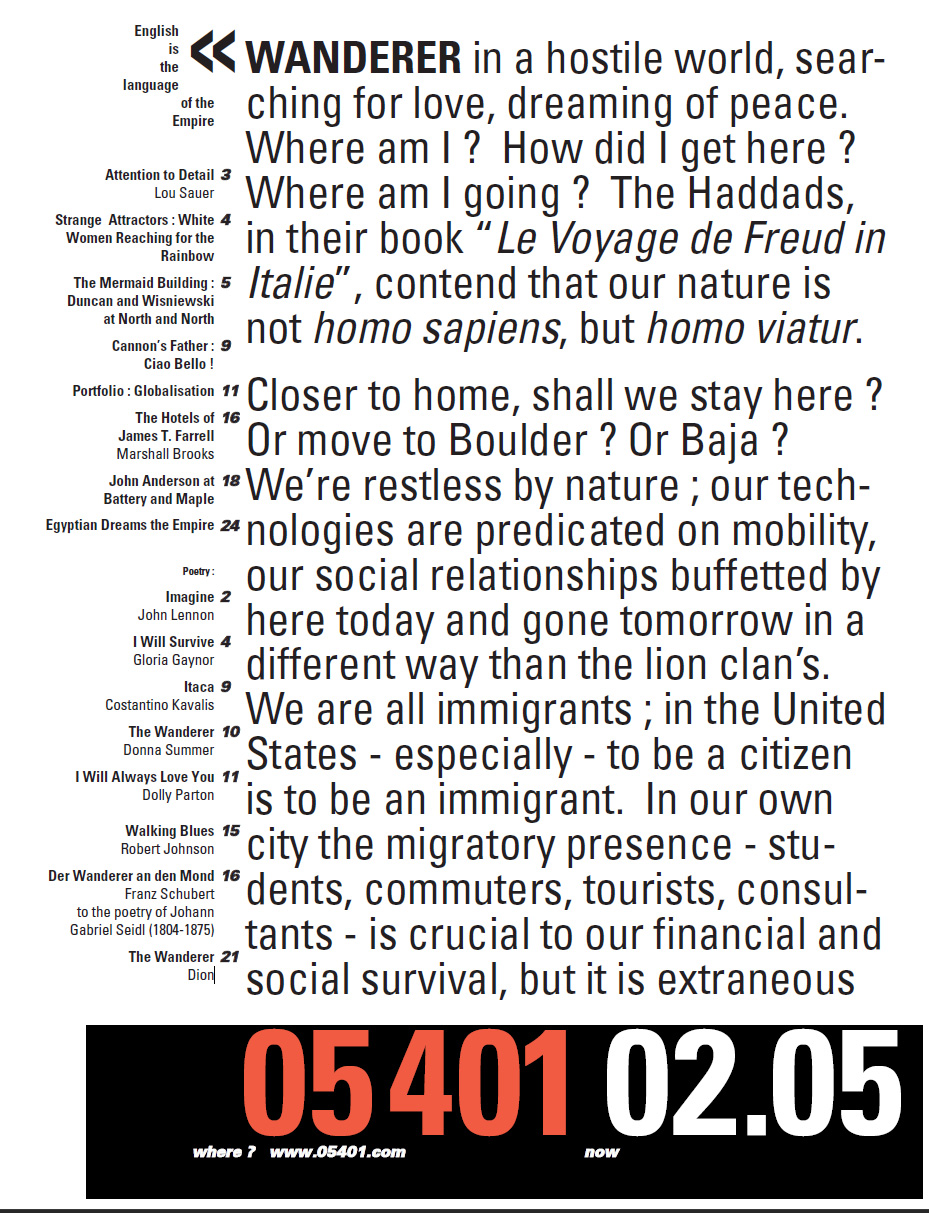
February 2005 – Wanderer in a hostile world
English is the language
of the Empire
Attention to Detail
Lou Sauer
Strange Attractors : White
Women Reaching for the
Rainbow
The Mermaid Building :
Duncan and Wisniewski
at North and North
Cannon’s Father :
Ciao Bello !
Portfolio : Globalisation
The Hotels of
James T. Farrell
Marshall Brooks
John Anderson at
Battery and Maple
Egyptian Dreams the Empire
Poetry :
Imagine
John Lennon
I Will Survive
Gloria Gaynor
Itaca
Costantino Kavalis
The Wanderer
Donna Summer
I Will Always Love You
Dolly Parton
Walking Blues
Robert Johnson
Der Wanderer an den Mond
Franz Schubert
to the poetry of Johann
Gabriel Seidl (1804-1875)
The Wanderer
Dion
February 2005 – Wanderer in a hostile world
Colin Lindberg eclipses Marcel Beaudin on the Burlington Waterfront
(With apologies to Colored Girls Who Have Considered Suicide When the Rainbow Is Enuf.)
Barry Levinson : “You’ve got Terry Malloy, this ex-fighter who is basically a bum, who works for this crooked union boss. Malloy’s brother, Charley, is another crooked big shot in the organization, and they have this very complex relationship. Then you’ve got Karl Malden as this priest who decides to come down from the pulpit and go out into the streets to help clean things up, and Eva Marie Saint as this girl from the convent who has to deal with her brother’s murder by the gangsters. Look at how many characters there are at work in this story, and they’re all so rich. I may be wrong, but I just think this is much, much fuller than the way stories are told today for the most part.”
Ok ! So Progressive Burlington is not Nazi Berlin ; it is not Communist Moscow ; it is not even – although if we had to choose between the three some of us would pick this one as the lesser of three evils – Fascist Rome.
How is it then that we can observe a development scenario on the waterfront that so resembles the (successful) processes that characterized the authoritarian modernization by Adolf Hitler, Joseph Stalin and Benito Mussolini of those three other cities through meteoric boom and burnout during the last century ? There may be some disagreement on Hitler’s inclusion on this list. We are told he was a frustrated artist, (a poor representational painter), and Germany had already gone through its modernization process. We might want to explore in this context the struggle around modernization in Muslim cultures/states, the power of (and the prescriptions against) images and words.
The Waterfront :
During the 19th century industrial and commercial activity on the waterfront fueled Burlington’s growth. The location and the activities of the harbor were the sources of economic prosperity and cultural development. By the 1970’s the waterfront had reverted to wildness, if not wilderness. It offered an authentic albeit circumscribed immersion in nature at the very edge of the city, just blocks from downtown. It was, in the peculiar way of nature, accessible – at a price. Even the more conventionally artificial parts of the waterfront – e.g. the parking lot at Perkins Pier – were not only accessible but free, and self-regulating.
Those qualities – free and self-regulating – and the natural disorder of much of the waterfront land were anathema to the development “community”, that motley band of investors, speculators, bankers, architects, engineers and lawyers and accountants and bureaucrats who seem to be addicted to the potential profits of environmental transformation at any cost.
Why would Bernie Sanders – if not exactly a Socialist certainly a genuine progressive at the head of a genuinely progressive political and social movement – be in cahoots with the proponents of such a particularly provincial and ignorant – in the most charitable sense of the word – gang of suspects ? I would guess that more than Real-politick – needing allies to secure the social program – the progressive Mayor and his political consultants were driven by shortsighted-ness, naivet? and opportunism plus the attraction of opposites, the thrill of being who they had historically opposed (forbidden fruit : Bernard Trump ? The Bernard ?), the endless necessity of repudiating miscegenation, homophobia etc. and of course the necessarily centrist nature of mayoral politics.
The Alden Plan was the centerpiece of Mayor Sanders’ vision for the development of the waterfront. It joined progressive rhetoric and a retro contemporary imagery with traditional notions of exploitation and speculation. It envisaged the waterfront as the playground of the new consumers : a mix of boutiques, upscale apartments and condominiums and a sprinkling of “community” access to “community” facilities.
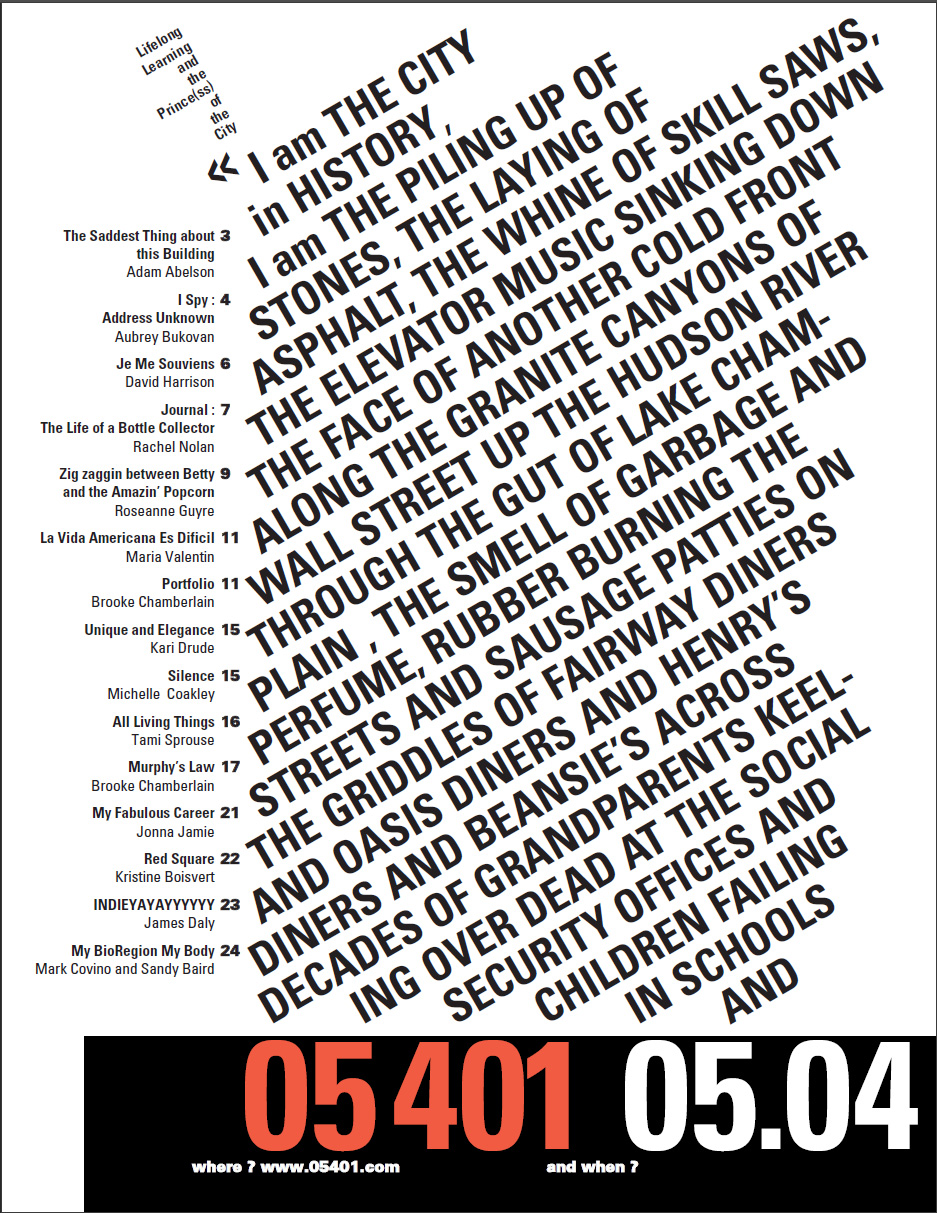
May 2004 – The Burlington College Issue
The Saddest Thing about
this Building
Adam Abelson
I Spy :
Address Unknown
Aubrey Bukovan
Je Me Souviens
David Harrison
Journal :
The Life of a Bottle Collector
Rachel Nolan
Zig zaggin between Betty
and the Amazin’ Popcorn
Roseanne Guyre
La Vida Americana Es Dificil
Maria Valentin
Portfolio
Brooke Chamberlain
Unique and Elegance
Kari Drude
Silence
Michelle Coakley
All Living Things
Tami Sprouse
Murphy’s Law
Brooke Chamberlain
My Fabulous Career
Jonna Jamie
Red Square
Kristine Boisvert
INDIEYAYAYYYYYY
James Daly
My BioRegion My Body
Mark Covino and Sandy Baird
May 2004 – The Burlington College Issue
Tami Sprouse : I grew up in West Virginia where there were very few social programs to help those in need. The Ohio river is so polluted that swimming is out of the question, and the cancer rate is off the charts. When I first moved to the Burlington area I immediately saw how different these two states were and felt blessed to be here. I felt like I had found some sort of Utopia were all the people were environmentally conscious and open- minded. After being here a while the infatuation subsided and I started seeing big problems. Most of these revolved around animal welfare issues.
Last summer I was driving locally on the interstate where the lines had been freshly painted. I looked over to the left and saw a dead possum that had the yellow line painted over it. This image really disturbed me and as I went through my day a told a few people about what I had saw. One man looked at me and started laughing after I had told the story and equated it to old episodes of the “Road Runner” cartoon. This greatly offended me and when he realized this he told me how much he really loved and cared for animals. It seemed to me in listening to him that his love for animals, and a lot of other peoples’ as well, is limited to selected animals and did not reach the possum that was hit on the road, left to die, and then painted over with a yellow line. It is this cognitive dissonance that both infuriates me and baffles me at the same time. In saying this I feel like I also need to say that as I get older I realize that things are not just black and white. There is a gray area that we must all live in and as hard as it is to swallow sometimes, that gray area translates to hypocrisy. It’s hypocritical to profess to loving animals and then laugh at the death of one. It is also hypocritical to feed and adore the family pet and then put poison out, or other traps that will not only kill unwanted small animals that may come in, but also slowly torture them in the process. This attitude was present in a public way again a few months later when I was listening to a local radio station. The DJ was complaining that she had purchased a house and appalled that a skunk was in her neighborhood and that she would have to pay to have a pest control company come to kill it, that the police or other public officials would not take care of it for her. She went on to talk of how she was disgusted by the smell and could not enjoy the comfort that she was entitled to when purchasing a home. I have heard it said that Burlington is a unique city, because it has one foot in its rural background and one foot in its urban future. Urbanization is a costly process in many aspects, but one aspect that is overlooked a lot is the cost that it brings to our wildlife neighbors. On a daily basis wild animals get hit by cars, ran out of their homes or poisoned. This is the price that they pay for our cities, homes and automobiles. Most people don’t know what to do to help them, or feel that it isn’t their job to do so. This attitude is not acceptable. Many times when animals are hit by cars they do not die. They lie on the road and suffer until they die from injuries or being hit again. They get smashed into the pavement and continually hit until the street cleaner comes by. If a small child were dead on the side of the road, it would not be treated in this manner. The whole city would be turned upside down. With so many social service agencies in the area and environmental groups I am surprised that this way of interacting with our environment has become a norm. On the positive side, however there are many people that deviate from this norm and work to make things better for our animal citizens. There are a group of wildlife rehabilitators in the area that are permitted by the state through the Department of Fish and Wildlife that take in some orphaned or injured wildlife and rehabilitate them until they can be reintroduced into the wild. These people work on a volunteer basis and purchase all their supplies out of pocket. During the spring and summer months they are usually overwhelmed by cases. A lot of these animals end up being baby orphans that are found after the mother has been killed in some of the ways mentioned above. What is the solution to this problem? There are no simple answers. Burlington is continuing to grow and that’s not going to stop any time soon, I am quite certain. But there are some things that we can all do to help.